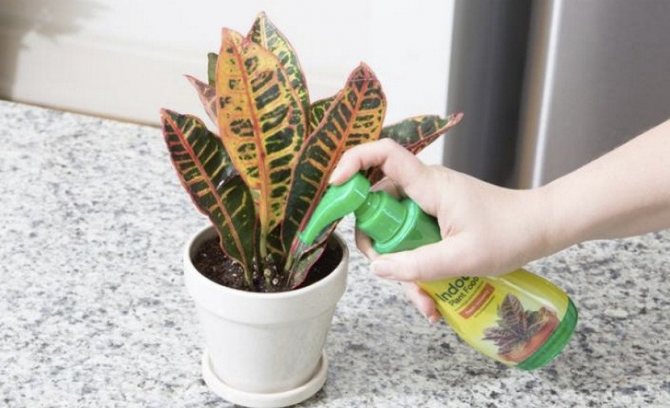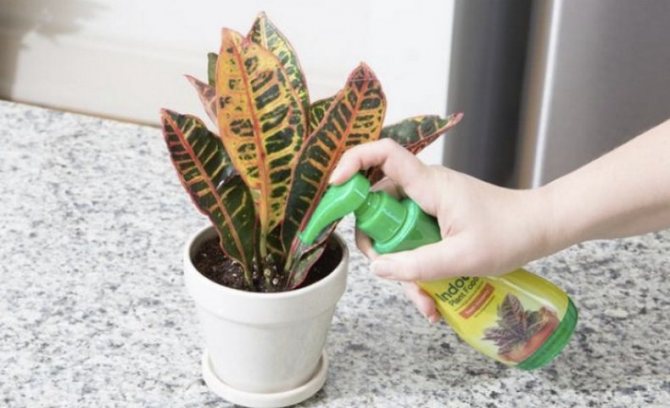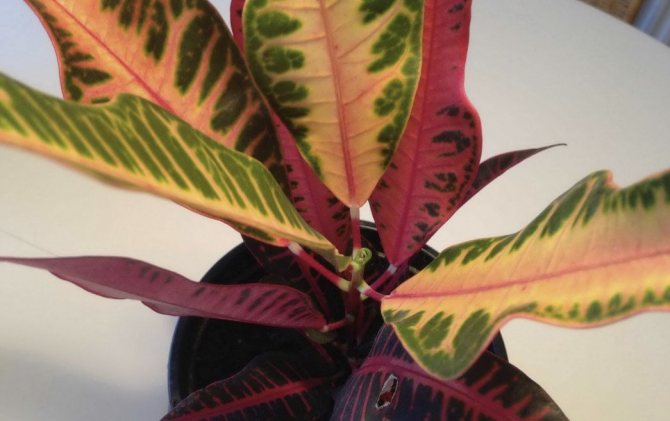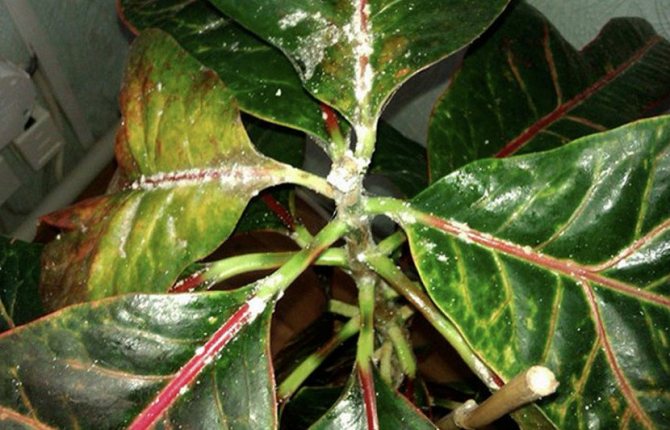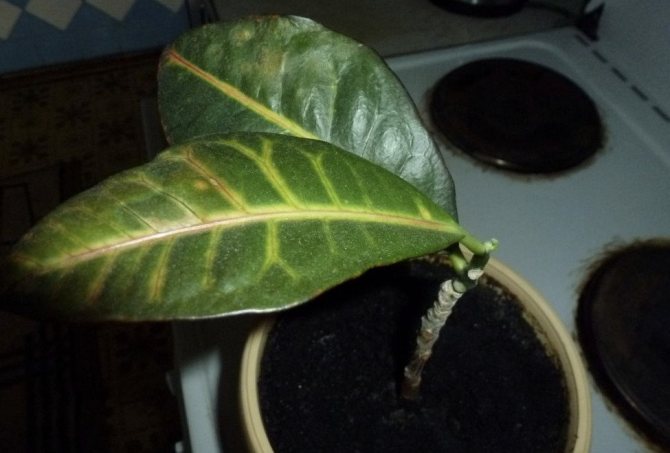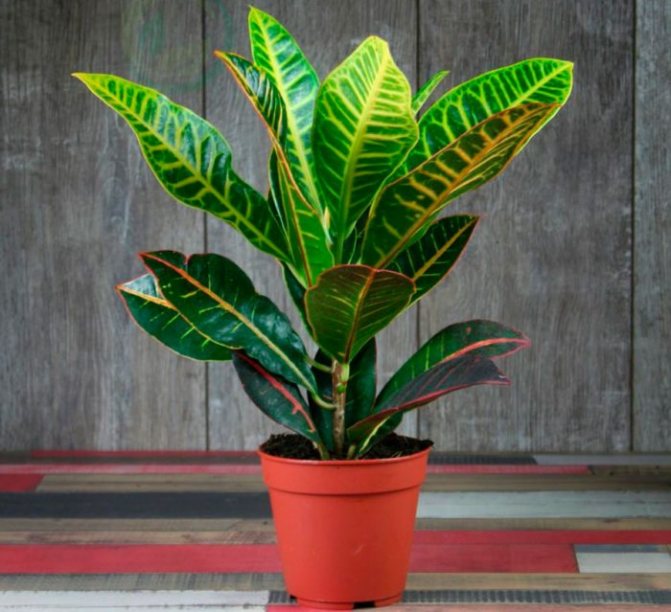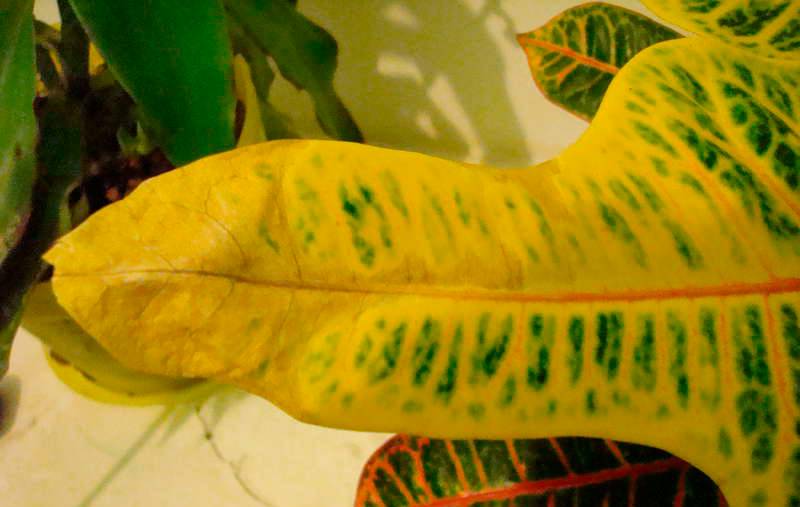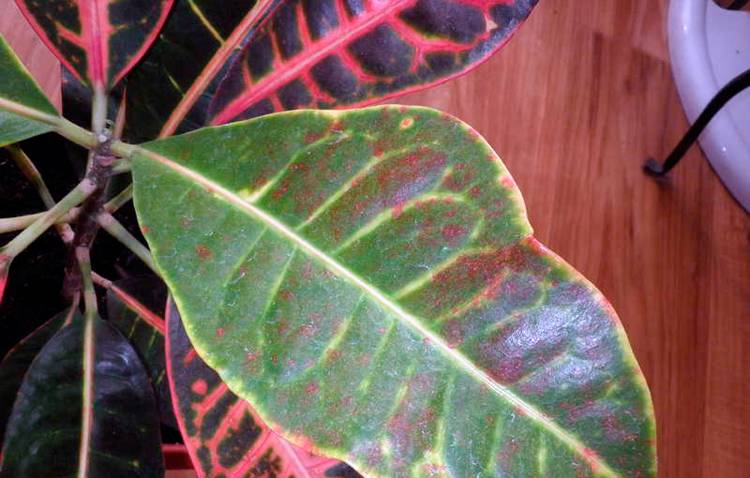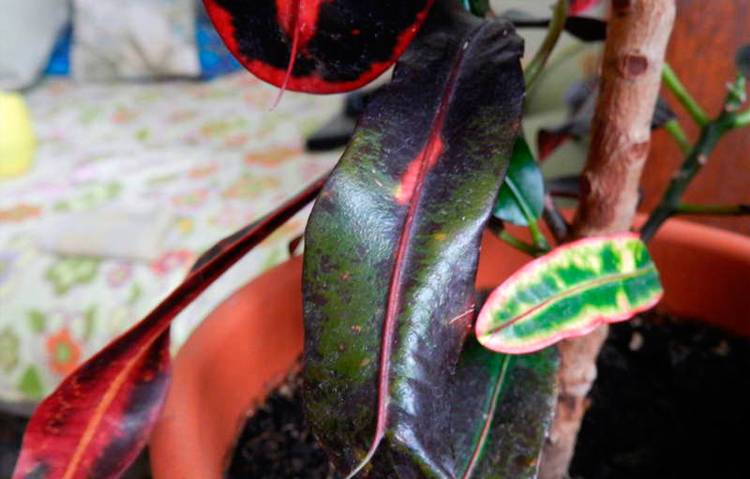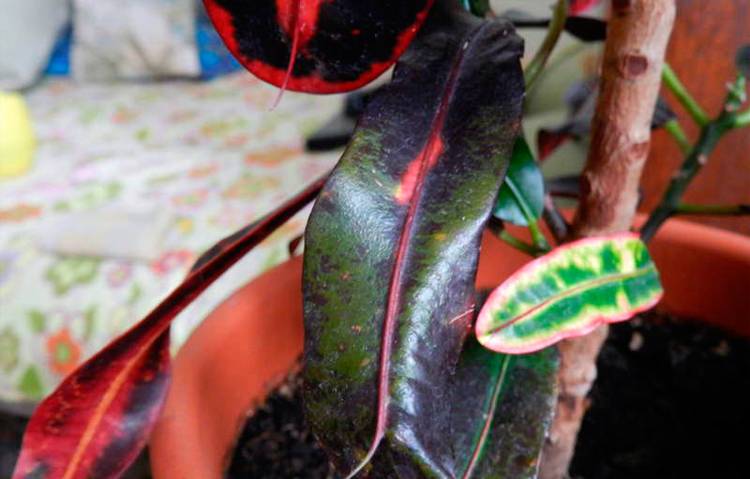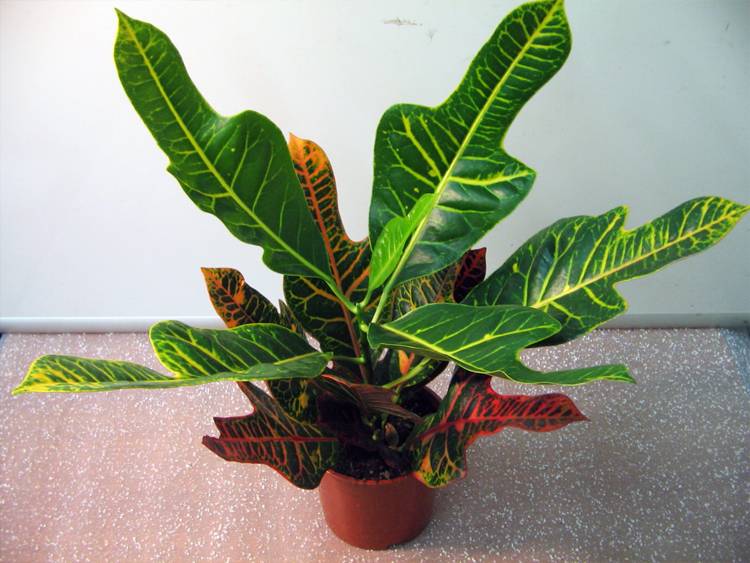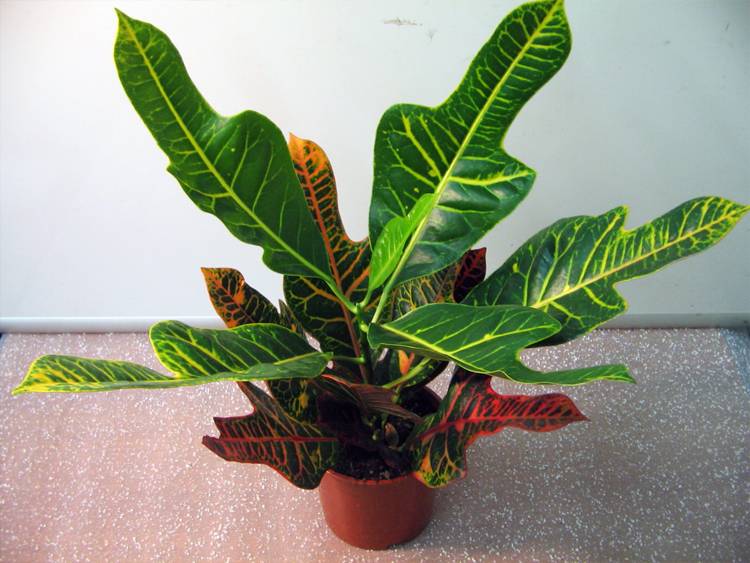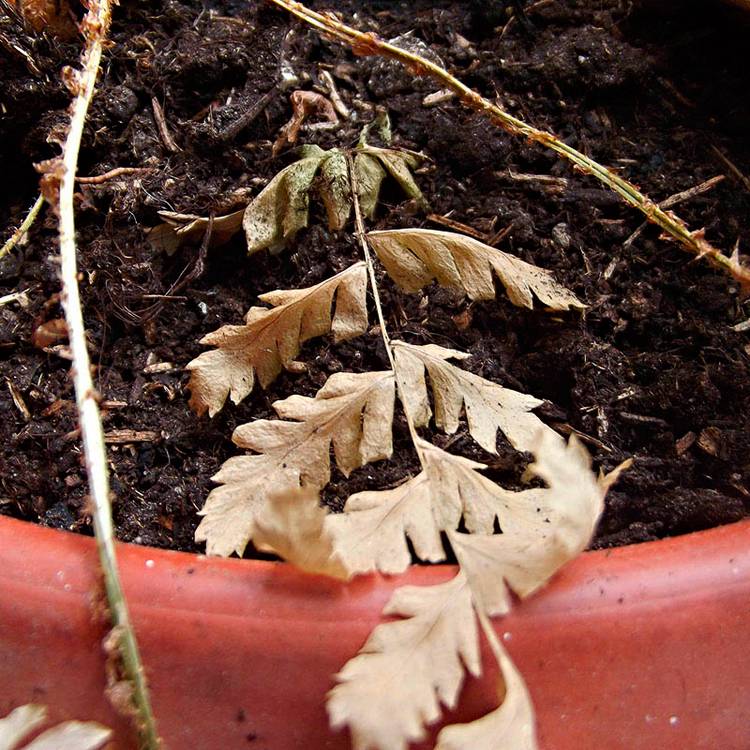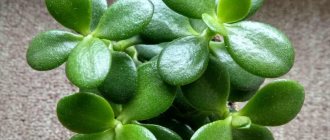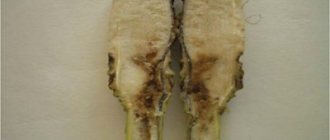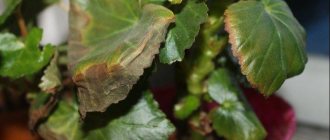Even experienced gardeners sometimes encounter such phenomena as wilting, Croton leaves turn yellow and fall off. Sometimes the tips of the leaves dry out or they themselves change color, turn yellow.
Let's talk about why croton leaves dry and fall? What other diseases and treatment may Croton have, and also we will figure out what problems may appear when growing and reproducing codiaum.
Croton species are very popular in breeding: Motley, Petra, Excelent, Tamara.
Croton - leaves dry and fall
| Powdery mildew on violets - treatment Violets, loved by many flower growers, are very beautiful, but, alas, they are often affected by diseases and pests. Most often, violets suffer from powdery mildew. Fortunately, pets are not that difficult to heal. Read more about the treatment of violets from this disease in our article. | Why do the leaves of the money tree turn red? The money tree is considered one of the most resilient plants. However, he may have “health problems”. Many owners of fat women noticed that the leaves of plants sometimes turn red. Why this happens and what to do in such a situation - we will tell in the article. |
| Geranium - propagation by cuttings in water Geranium is considered one of the "classic" indoor plants - it is beautiful, fairly easy to care for and reproduces very easily. Most often, flower growers use cuttings. Read more about the propagation of geraniums by cuttings in water in our article. | Croton - propagation by cuttings Croton has become popular among flower growers due to the unusual colors of variegated leaves. Very often, having seen this plant from friends, I want to get one myself. Fortunately, crotons reproduce quite easily. Read about croton propagation by cuttings in our article. |
Insect pests and diseases
This houseplant rarely gets sick, as it is poisonous. But if you don't take good care of him, he can get sick. The most common diseases are:
- Anthracnose is a fungal disease that occurs after frequent watering with cold water. Red or gray spots appear on the leaves, after which the fungus penetrates even deeper, thereby completely destroying the flower. If these signs of the disease are detected, the croton pot is urgently taken to another room where there are no home flowers. Then, not only him, but also the rest of the greens in the room is treated with an antifungal drug.
- Root Rot - Soft and yellowed leaves indicate infection with this fungal disease. To save the croton, it is transplanted into a new container with fresh soil and mandatory drainage at the bottom. During this procedure, the damaged parts of the roots are cut off and the wounds are washed with a weak solution of potassium permanganate. Then everything is treated with an antifungal agent.
- Spider mite - Its appearance is evidenced by the presence of a thin cobweb and white bloom on the stems and leaves. To get rid of it, the leaves are washed with soapy water and every week they are thoroughly treated with any insecticide, for example: Fitoverm, Aktellik. After that, the percentage of moisture is increased and the home flower is regularly watered.
- Mealybug - A sign of its presence on the leaves is a light-colored fluffy bloom on the leaves.All greens are washed well with soapy water, after which all parts are greased with vegetable oil. If this does not help, then they treat it with Karbofos.
- Scabbard - She rarely affects him. Brown spots on greenery indicate the presence of this pest. They are removed with a sponge dipped in soapy water. Usually this treatment is enough to get rid of this pest.
Why Croton sheds leaves: causes and fight against them
After 2 hours, it is necessary to drain the water from the pan so as not to harm the roots (by the way, check their condition by pulling the plant out of the ground; if there are rotten roots, then they must be removed from the cut point by treating the cut with crushed activated carbon to exclude the disease). Before the next watering, the TOP soil layer should dry out slightly. In winter, watering is more moderate (i.e. water when the soil dries up 2-3 cm deep). At the bottom of the pot, drain well to avoid stagnant water. Good luck!
And water? Maybe not watered for a long time? Croton loves moisture and, if underfilled, lowers the leaves.
first, take out the plant of their pot and inspect the roots - maybe there is nothing to save. according to the condition of the roots, you will see - underfilling or overflowing - you will take appropriate measures. in general, crotons do not like temperature drops and temperatures are below 18 degrees. for a long time (5-6 hours is enough) it is already critical for the plant, especially if the flower was recently watered - wet roots cool faster. the temperature is above 26 degrees. - also poorly tolerated, especially if the humidity is low - when the batteries are turned on, the air humidity drops significantly. - increase the humidity using the methods available to you.
There can be many reasons: overflow or overdrying of an earthen coma, draft. temperature difference, the presence of a pest, transplanting, moving from place to place. It is necessary to adjust the watering - water after the earthen clod dries by half. be sure to maintain high humidity. Spray the plant with epin once a week - it will help to recover. If the ground is too wet now. then it is necessary to wrap an earthen lump with newspaper or toilet paper, change as it gets wet.
Pests and Diseases: Affected by the red spider mite and scabbard.
Special difficulties:
Falling of lower leaves - brown tips of leaves - air or soil too dry.
Brown edges of the leaves - too low temperature.
Leaves lose color - not enough light.
Features of care: The plant is poisonous!
If the leaves begin to lose their color, it is necessary to increase the lighting.
In horticulture, codiae are sold after hardening - for this, the temperature is reduced to 20 ° C, and then to 18 ° C. Plants prefer moderate heat throughout the year. The optimum temperature for codiaums is not less than 20 - 22 ° C, but they are able to withstand lower winter temperatures (but not lower than 16 ° C) if the soil is almost dry. Bloom annually and abundantly. With a prolonged stay at a temperature of 10-12 ° C, the leaves crumble. Plants can be placed near radiators by wrapping the pots in moist moss that evaporates the water.
Codiae does not like temperature changes and drafts very much.
Connoisseurs of flower beds on windowsills often collect the most valuable collections of indoor plants. Selection criteria can be very different: someone likes flowering, someone likes succulents, for someone the main thing is ease of care, and for someone it is more important to combine plants with each other and to form harmonious compositions by them. Among all the abundance there is one and many ignore it. It is difficult to find a more beautiful, but also more demanding plant than croton (the leaves dry and fall off at the slightest mistake of the owner). But the main beauty of this "pet" is precisely in the foliage, since it blooms quite plainly.And yet there is a certain attraction in it, forcing plant breeders to try again and again to get a capricious person in their flower garden.
Shield
Shield aphid infrequently affects codiaum, but you must always be ready.
As a rule, you can get rid of the scale insects, simply deleting them manually.
Brown spots on plant parts - this is a vivid example of the appearance of scale insects. For complete disinfection, treat the flower soapy water, for 1 liter of water, add 2 tablespoons of vodka and rub a little soap.
Wipe the leaves and stems of the plant with this solution.
Then leave it like this for 2-3 hours, then rinse under the shower faucet.
Description of the plant
A native plant from the tropics. And there this shrub from the category of evergreens reaches up to one and a half meters. Croton at home has a much more modest size: 70 cm is considered the maximum height for nago, but usually it is half as small. The leathery leaves of the plant - its main pride - often resemble laurel, but there are often variants of ribbon-like, elegant curl and carving in the most bizarre way. Young shoots are yellowish or greenish in color, but as they grow, they become dappled, acquiring bright spots of warm shades. It is not surprising that the owners are upset when Croton is sick - the leaves dry and fall off, and the plant greatly loses its attractiveness.
Description of croton, or codiaum

Croton flower photo and how to care for a photo
Croton in indoor conditions is a bush. Its leathery leaves are diverse in shape: asymmetric, oblong-lanceolate, pointed or with a blunt end, whole-cut, three-lobed, notched, broadly ovate, etc.
Young leaves have a light yellow-green hue, and with age they become more saturated green and burgundy, so that the croton looks like an elegant autumn tree. All plant varieties and varieties have a pronounced venation on the leaves.
How croton blooms
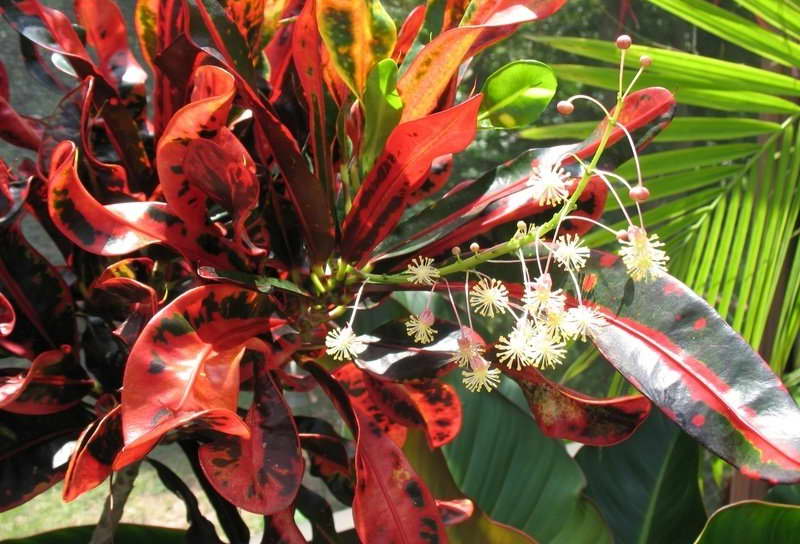

How croton blooms photo
Croton bloom - nondescript cream flowers, collected in an axillary folded carpal inflorescence, bloom does not cause much delight.
Dangerous and effective
Home croton is considered one of the most capricious plants. Consider the following care features:
- All work with croton must be carried out strictly with gloves, because its juice is poisonous and causes contact dermatitis, vomiting, and diarrhea.
- At home, croton needs not only to spray the leaves, but to wipe them with a damp soft cloth or sponge. In summer, it is recommended to bathe monthly under a warm shower.
- The plant categorically does not tolerate drafts and cold watering.
- At the beginning of the growing season, sometimes croton leaves can take on the most bizarre shapes. This is most likely due to the high mutation ability. Thanks to such an amazing variability, many varieties and hybrids of Croton are bred, which differ only in the shape of the leaves.
- Peduncles and flower buds are recommended to be removed immediately, because they do not bring aesthetic pleasure and take a lot of energy from the plant.
Temperature requirements
You should never forget that the flower you like is very capricious. It is necessary not only to know exactly how to care for a croton, but also to follow all the rules unswervingly, otherwise it will not live with you for a long time. One of the most important parameters is temperature. First, it should never fall below 17 Celsius. Moreover, this is a critical threshold at which problems with the plant can already begin. Roots rot, after which it is extremely rare to save croton. The optimum temperature range is between 20 and 22 degrees. Secondly, there should be no sudden temperature jumps. On the eve of winter, it is better to turn on the heater in advance or equip the Croton with a mini-greenhouse. And thirdly, the complete absence of drafts. For the death of a flower, it is enough to keep it on the "wind turbine" for a quarter of an hour.
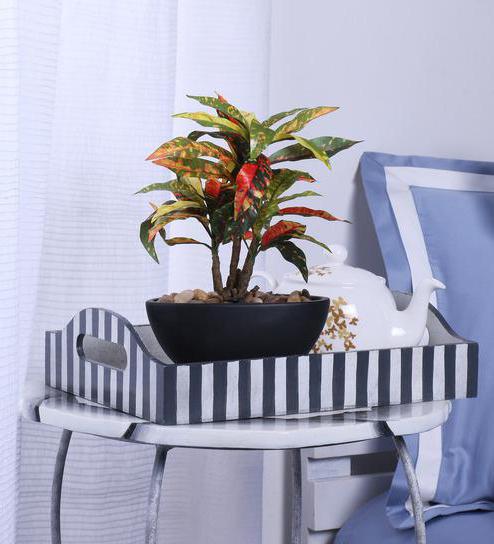

Gray or brown spots
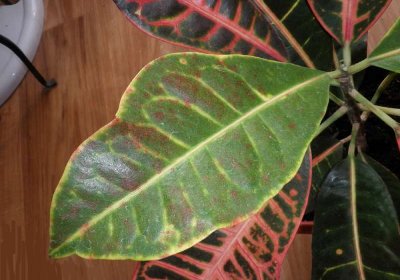

These are the manifestations of anthracnose - a fungal disease that can appear due to an excess of moisture, it can be excessive abundant watering or high humidity.
For treatment it is necessary 3-4 times treat the plant with fugnicide.
You need to do this with a break. in ten to twelve days.
Moreover, processing should be done not only for the leaves, but also for the soil.
Lighting requirements
Light is the second factor that can ruin your cultivation. Croton requires a lot of sunlight, but not direct ones - they burn the leaves, which are unable to recover. In winter, it is better to keep the flower on the south or east window - the rays are cold, and it receives only what it needs. As summer approaches, the pot needs to be moved to a quieter place, north or west. Moreover, you need to gradually accustom the plant to a more intense sun. If you do not guess with the degree of illumination, the leaves will turn primitive green, and the croton will lose 90% of its attractiveness.
How to care for croton at home
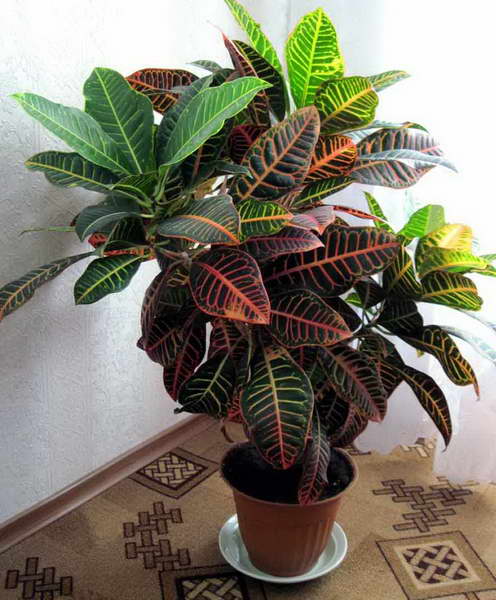

Croton flower home care photo
Lighting and temperature
Croton needs a bright light. It can be placed in direct sunlight in the morning or before sunset. In summer, expose to the north window, and in winter, when the sun is shining, but not very warm, to the south. If possible, take the plant out in the summer to fresh air under bright, diffused light. The most comfortable air temperature in summer will be 20-22 ºC, and in winter - at least 16 ºC.
Watering
Croton should be watered so that the soil is constantly wet, but moisture should not stagnate at the roots and create a risk of rotting. The water must be warm, it must be filtered or at least defended during the day. Air humidity is also of great importance. You need to regularly spray the plant, wipe its beautiful leaves with a damp sponge, once a month in the summer, bathe under a warm shower, but the water should not flow into the pot.
Top dressing
The plant is fed with complex mineral fertilizers for decorative deciduous. The soil must be pre-moistened and top dressing must be applied in a dissolved form during the period of April-November - twice a month, in winter - once a month.
Crown formation: pinching and pruning
To form a beautiful bush, young crotons are pinched, and older plants need to be cut off. Pinch the plant as soon as it reaches 15 cm, and then each time the shoots stretch 20 cm.
How to cut a croton peduncle, we look at the video:
After pruning adult plants, the cut sites should be treated with charcoal or sulfur powder. The bloom of croton will only take away his strength and affect his healthy appearance - it is also better to remove flower stalks and flower buds immediately.
Transfer
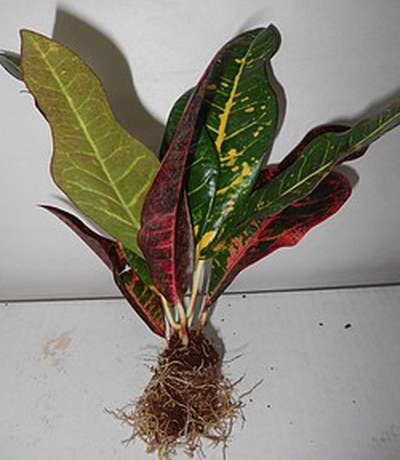

How to transplant Croton photo
Young crotons should be transplanted twice a year (preferably in spring and autumn), and mature crotons once every two years, each time the pot must be increased in diameter by 2 cm from the previous one. When your croton grows to a pot with a diameter of 25 cm, you no longer need to transplant it, but simply replace the top layer of the substrate from the pot with a new one every year.
Pick up the soil approximately of the following composition: in equal proportions, mix turf, peat, leafy soil and add a little sand. During transplantation, it is better not to disturb the earthen lump, but to transfer it into a new container. The drainage layer should take up about a quarter of the pot's volume.
Read also: What fruits are obtained from a melon tree
How to transplant Croton after purchase, we look at the video:
The most important detail: watering
The correct dose of water is the key to the survival of any plant. Indoor croton requires good soil moisture. In warm, and especially hot months, the soil should not be allowed to dry out deeper than a centimeter. In the non-growing season, the amount of moisture decreases, and the irrigation itself should become more rare.Water must have time to evaporate from the ground to a large extent, so as not to cause rotting of the roots. It is noteworthy that croton quite clearly makes it clear to the gardener about the lack of moisture: its leaves will drop in unison. To fix the situation is quite simple - unscheduled watering. But it is better not to bring it to this: it is stress every time, and the plant may not tolerate it.


Lack of nutrients
Like any plant, codiaum cannot grow properly without beneficial minerals. Due to the lack of these substances in the soil, the leaves become thinner, dry up, and then fall off. Therefore, the flower must be fed regularly. In spring and summer, it is fed every two to three weeks with any complex fertilizer for ornamental deciduous plants.
In winter, it is enough to give feeding once a month, and then it should be more diluted than in summer. Before fertilization, the soil is watered abundantly so that the roots do not burn.
Required humidity
The flower's tropical past requires maintaining a fairly high humidity in the room where it is located. During the months of active life, the plants should be sprayed daily and carried out with water at room temperature. It is possible (and even useful) to add fertilizers in a low concentration to it. In winter, when the radiators dry the air, spraying should be accompanied by wiping the leaves with a damp cloth and occasional showers (the ground must be covered with a film). Better to put a humidifier in the room. Or at least a bowl of water next to the pot.
Croton species with photos and names
In indoor conditions, motley croton is grown, which, depending on the conditions of existence, can change the color and shape of the leaves. Thanks to this quality, it has become the basis for the development of new varieties, hybrids and varieties.
Croton variegated or variegatum Codiaeum variegatum


Croton variegated or variegatum Codiaeum variegatum photo
In natural conditions, it is found in Pakistan and China, it can reach three meters in height. Short-petiolized leaves are colored green-brown. This species has several forms, differing in the outlines of the leaves, which can be appendage, lobed, flat-leaved, ornamented.
Interesting varieties are:
Croton Mrs. Ayston Croton codiaeum iceton photo
Mrs. Eiston is a large bush or tree, maroon leaves with bright pink spots, can be golden with almost black blotches, and there is also a variety in pink-yellow tones.
Read also: Magazines about the garden and vegetable garden
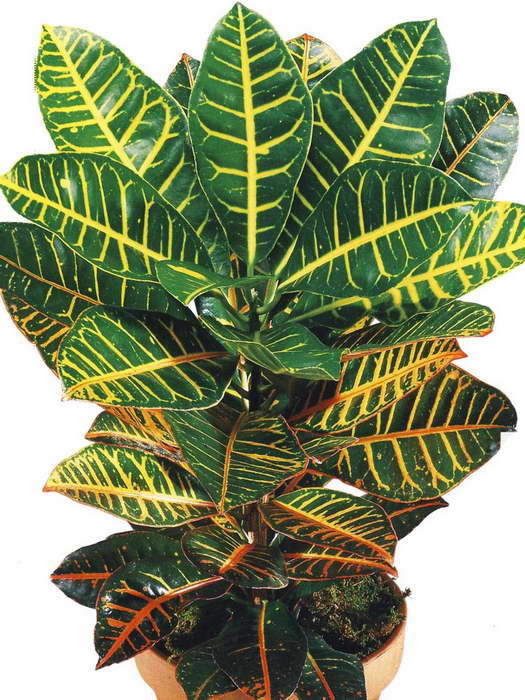

Croton Petra photo
Petra - in the natural environment it reaches a height of about 4 meters. Leaves are oval, lobed or pointed, painted dark green, edging and streaks of bright yellow.


Codiaum motley Black-Prince photo
Black Prince - the leaves are flat, broadly oval, painted in black-green and covered with many spots of yellow, red, orange.
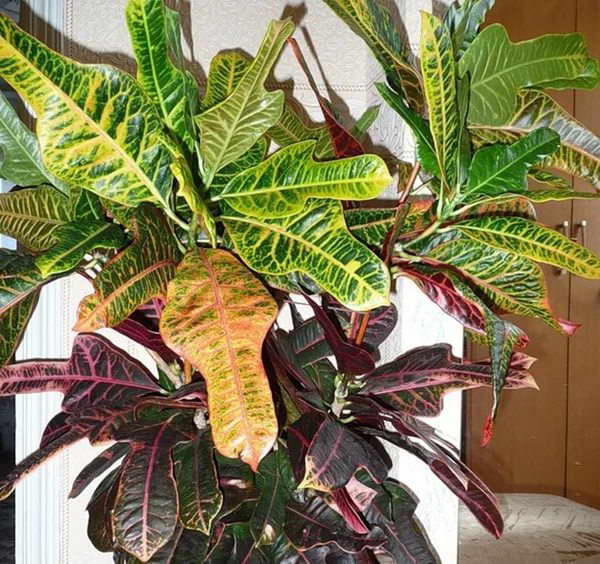

Croton Disraeli photo
Disraeli - the shape of the leaves is lobed, the upper part of the leaf is colored green with veins and interspersed with yellow color, the lower part has a brick-brown color.


Croton Excellent photo
Excellent - in shape the leaves are similar to oak, the upper part is painted yellow-green, the lower one has a red-burgundy color.


Croton Gold Finger Codiaeum variegatum Gold Finger photo
Such varieties of variegated croton as genoin, oval-leaved, tortoiseshell, mollux, spiral, "minus" are very interesting. Absolutely any item will become a noticeable decoration of your home.
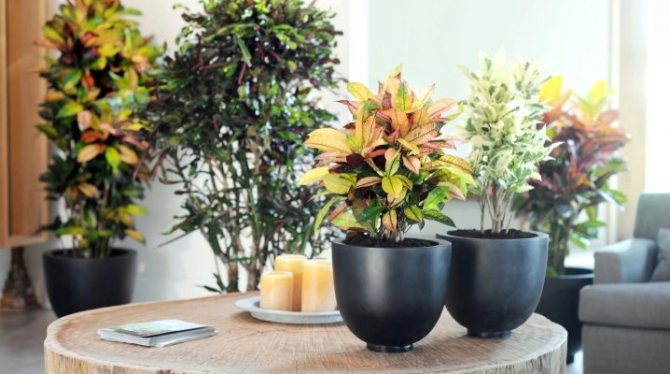

Croton has long and rightfully won the hearts of flower growers. This is an amazingly beautiful plant with a bright unusual color of leaves, which reaches a meter in height in several years. In addition, this flower is very unpretentious.Probably the only problem faced by its owners is yellowing and discoloration of the leaves.
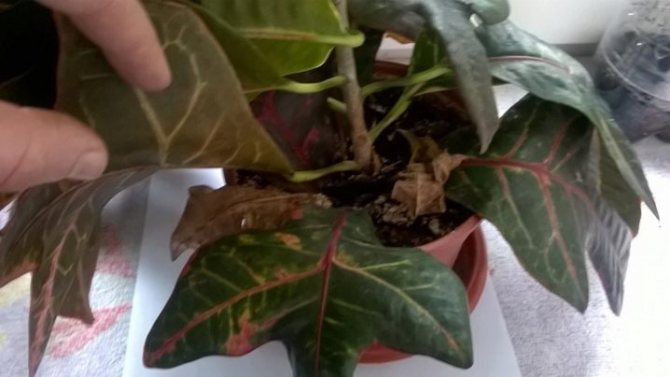

Other features
Croton has certain nuances in life and care that you need to know about.
- The plant blooms regularly, abundantly, but ugly. In this case, the forces are taken away from the whole plant: the leaves become smaller, and growth slows down. So the ovaries should be torn off.
- Transplantation of young plants is carried out every spring in low pots by transferring. Old plants need to be transplanted no more than once every three years. More frequent relocations harm them.
- Homemade has poisonous juice. It is difficult for them to become seriously poisoned, even if you chew the stalk, but the irritation is removed with difficulty. So after all the manipulations with the plant, it is better to proactively wash your hands, and with soap and water.
By the way, the last factor explains why indoor croton is rarely affected by pests. They just don't like the poison produced by plants. However, if the leaves are rarely rubbed and sprayed, the flower may be affected by spider mites or scabies. The most reliable way to remove both types of pests is to wash the leaves with tobacco infusion with household soap diluted in it, or with the addition of kerosene. Most attention is paid to the underside. In this case, the earth is closed from the penetration of the "medicine" with polyethylene, and after a couple of hours the plant must be rinsed with clean water.
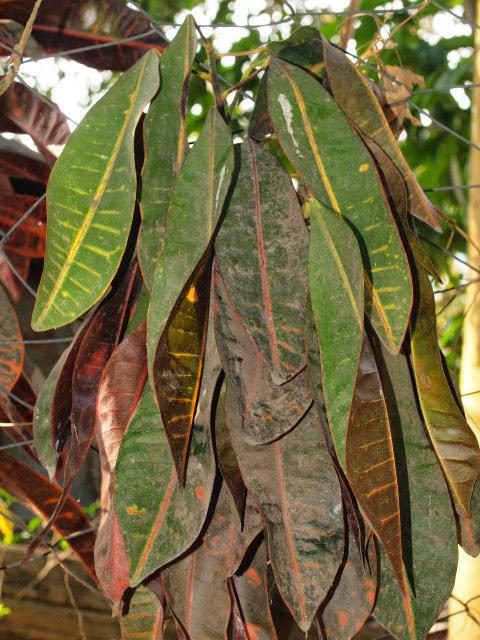

Croton propagation by cuttings
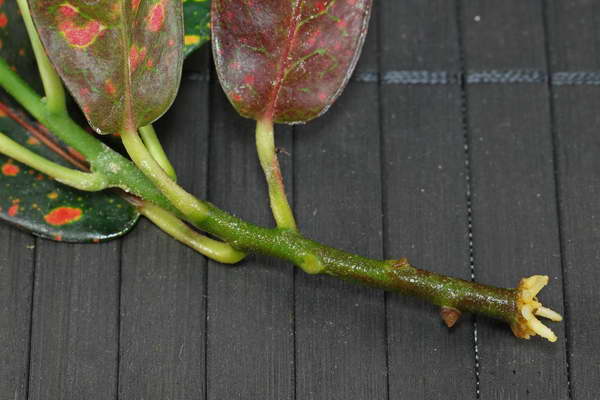

Croton stalk how to root a photo
For vegetative propagation, apical cuttings 6-10 cm long are used. If you want to get several cuttings, you can open the shoot into pieces so that each piece contains one internode with one healthy leaf. Semi-lignified and lignified cuttings root best of all.
The poisonous milky juice flowing out of the slices must be washed off with water and allowed to dry for three hours in the air. Then treat the cut with root root (growth stimulant) and place the cutting in water and heat it to 23-30 ºC (so that the planting material does not rot).
Lighting needs bright and diffused. When roots about 2 cm long appear on the handle, transplant it into a substrate for codiaum (croton). During the first 15 days after transplanting, it is necessary to frequently spray the plant in order to create increased moisture. When the leaf regains its elasticity, then the cutting has begun.
Capricious croton: leaves dry and fall off - possible causes
Even diligently caring for plants, lovers of home gardens are often faced with the stubborn desire of "pets" to get rid of the deciduous cover. It is imperative to fight this, first of all, by finding out the cause of the Croton blues. There may be several of them.
- Dry air. She is the most common culprit. Try to spray the bush more often.
- Drying out of the soil. Remember: not deeper than a centimeter! If the rule is regularly violated, it is not surprising that the plant sheds excess weight.
- Mite. Despite the poisonousness of the plant, he often tries to feast on them, so it is worth examining the "pet" for pests.
If you have a young, recently purchased croton, the leaves dry and fall off from him, most likely this is due to the poverty of the soil in which he lives. No later than a couple of weeks after purchase, it must be transferred into a nutrient soil from equal shares of leaf, sod, humus soil, sand and peat with the introduction of charcoal. And then - regularly feed it with complex fertilizer: weekly in spring and summer and monthly in the rest of the year.
Hello! My croton's leaves dry and fall. I follow the watering, there is enough light. What could be the reason? What to do with it?
Hello! I would like to get more information about your houseplant, so you can give more accurate advice.Leaves can turn yellow in different ways (at the tips, spots, evenly, etc.), fall off at different rates. From such a general question, several general recommendations can be made.
Croton (the second name is codiaum) is a whimsical and demanding plant. Any violation of light, temperature or water conditions can lead to problems, in particular, falling foliage.
There are several main reasons why Croton's leaves dry and fall off:
- various diseases;
- pests;
- excessive or insufficient watering;
- too dry indoor air;
- violations of the light regime;
- during the period of adaptation to new conditions;
- too hot or cold in the room;
- natural leaf replacement process.
We will not dwell on the last point for a long time. It is worth noting that in this case the process goes gradually, smoothly, 1-2 leaves fall off. At the same time, new shoots always appear on the upper part of the plant, and the growth outstrips the fall, that is, the codiaum does not look "shabby". Symptoms indicating that something is wrong with Croton may include the following:
- few leaves remain on the stems, and this can be seen with the naked eye;
- weak growth of young foliage;
- young leaves turn yellow;
- the tips of the leaves dry up;
- yellowness appears in spots.
If you have recently acquired a plant, then it is quite possible that this is just a period of adaptation to new conditions. Even moving to another room is difficult. The flower acclimates and gets sick because of this. If suitable conditions are created for the culture, then after 1-2 weeks it will return to normal, the foliage will stop falling off, it will become bright.
In most cases, errors in the maintenance of the flower are to blame for the fact that croton sheds leaves.
Red spider mite
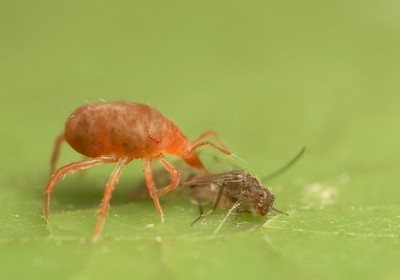

The problem you can face growing croton is pests.
The cobwebs on the plant are a clear sign that the codiaum is affected red spider mite.
The thing is that with normal growth the plant secretes a special milky juice, which serves as protection against this pest.
But if the conditions of its growth too dry, this juice is secreted in insufficient quantities and the plant endangered.
In order to rid Croton of such a sore, you need carry out triple processing means like Neoron, Aktellik, etc. with a break of 7 days.
Watering
The soil in the pot should be constantly slightly damp. In the summer you have to take a watering can every 2-3 days. Croton loves moist soil. In this case, not only the top layer should be wet, but the entire lump, to the bottom. Codiaum has a developed root system that goes deep into the earth. If the roots do not have enough water, then this will immediately be noticeable in the appearance of the plant: the leaves will begin to dry out. Prolonged lack of water intake is the reason why croton leaves fall off.
Excess water is no less dangerous. Usually the danger of "flooding" the plant occurs in winter. At this time, the need for water decreases in almost all crops, since they pass into a dormant period: the intensity of growth decreases, flowering and fruiting cease. However, the owners continue to water in the same amount as in the summer. With an excess of moisture, the roots rot, which is the cause of the death of the plant. Therefore, in winter they water it 2 less often: once every 4-6 days.
In order not to "pour" the codiaum, it is necessary to drain the excess water from the cup under the pot. A thick layer of drainage is poured onto the bottom. This will prevent root rot. With a decrease in the air temperature in the room, the irrigation intensity must be reduced.
Transfer
The newly purchased codiaum must be transplanted into another pot with soil consisting of leafy soil, peat, sand, charcoal, humus. They must be in equal parts. The transplant is usually done after the flower has acclimatized.This usually happens one month after purchase.
Acclimatization should take place in a room where there are no other flowers besides this flower, as it may contain hidden diseases or insect pests.
A young plant is first transplanted every year. This is usually done in the spring. The older the plant, the less often the transplant is carried out.
After transplanting, any crop often sheds its foliage. Here you just need to be patient, water and feed on time, soon the greens will grow back again.
If flowers have grown on it, and the greens have thinned out, then this is a normal phenomenon. Therefore, experienced florists recommend cutting the flowers so that the croton does not have to spend a lot of effort on growing them to the detriment of its growth.
Dry air
Dry air in an apartment is a common problem during the heating season. Croton does not like dryness. Because of this, the edges of the leaves dry out. You can save a flower with the help of a few simple measures.
- Place the pot with codiaum on a pallet with damp peat, moss or expanded clay. Add water regularly. Then it will constantly evaporate, creating a more favorable microclimate.
- Sprinkle regularly. For the procedure, it is advisable to use warm water that has settled for several days. It is desirable that it be at room temperature or 1-2 degrees warmer. Before sprinkling, it is advisable to wrap the pot with foil to avoid washing out the soil.
- Wipe the deciduous part with a damp cloth, napkin, sponge. This will not only moisten the croton itself and the air next to it, but will be an excellent means of combating dust that accumulates on the sheet plates.
- Use special devices - humidifiers, air purifier.
At a high level of humidity, the leaves of the culture do not wither for a long time, remain bright, and do not lose turgor.
Dry air, a large amount of dust provoke various diseases, become the reason for the attack of pests - spider mites. Due to the unfavorable microclimate, the natural immunity of the codiaum is greatly reduced.
Prevention of drying and falling leaves in Croton
In order to protect the plant from the attack of a spider mite, you should often spray croton, wipe the leaves with a damp cloth, arrange a shower for him, put a vessel with water near the plant, or place the pot on a tray filled with wet pebbles.
Scabbards and scale insects are quite easy to remove when they are few in number, so it is important to regularly inspect croton in order to detect pests in time.
It is advisable to find a suitable place for it in the house immediately after purchasing the plant: light, warm, without drafts. After acclimatization, croton can be transplanted into permanent soil: sod and leafy soil, peat, humus and sand in equal parts. There must be a drainage layer at the bottom of the pot.
Temperature regime
The flower is very demanding on temperature conditions. When the temperature is too low, almost all life processes stop in it, it stops growing. The codiaeum practically goes into hibernation. As a result, the leaves at the tips dry out and then fall off. The process starts at +14 ° C. If Croton has thrown off all "plumage", it is likely that he is already on the verge of death.
The reason why the croton has dropped the leaves may be too high a temperature. If the thermometer is above +24 ° C, and the air is dry, then it is likely that the flower feels uncomfortable precisely because of the heat.
Growing croton from seeds
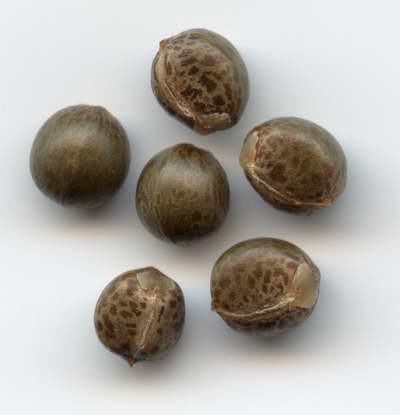

Croton seeds photo
Seed propagation is often used to grow croton. Seeds lose their germination very quickly, so only freshly harvested seeds are recommended to sow. Please note that the growing process will take a long time, plus the varietal characteristics of the plant will most likely not persist if the seeds are harvested from a hybrid.
- The seeds of codiaum are very large, before planting they must be kept for about half an hour in water with a temperature of 60 ºC and left for a day to swell.
- The seeding depth is 1 cm, it is better to plant it immediately in separate cups, but it is also possible to plant it in a common container at a distance of 3-5 cm.
- For seed germination, maintain an air temperature of 22 ºC and apply bottom watering until germination appears.
- Plants can be planted in separate cups with a diameter of 7 cm, when 3 leaves appear on them. Take care of it further as an adult plant, and then transfer to permanent pots.
Insolation
The lighting mode plays a big role. Croton also drops leaves in direct sunlight. If this behavior is noticed, it is necessary to rearrange the flower in a different place, more shady and cooler. If the exposure to sunlight was short-lived, then the culture will quickly recover: the leaves will rise again, become elastic, strong. If the codiaum has stood for a long time under the scorching rays, then the process becomes irreversible, the plant will only have to throw off the burnt foliage. Due to the regular excess of the sun, the indoor flower may die.
Temperature
Since codiaum belongs to tropical plants, the best air temperature for it is:
- In the summer, +24 o C.
- In winter +20 o C.
If the air temperature in the room dropped slightly below +15 ° C, then the codiaum almost stops growing, its leaves dry up, starting from the tips, until they completely fall off, and the roots begin to rot. In very hot weather with dry air, when the temperature exceeds + 25 ° C, the leaves become lethargic.
For the same reason, it is undesirable to expose Croton to direct sunlight. Partial shade is most suitable for him. And be sure to protect from drafts.
Deficiency of any substances
One more reason why the tips of the leaf plates dry in croton. Over time, nutrients are removed from the soil. If the flower does not have enough of them, it will begin to wither. At the same time, the leaves can dry out in different ways: go in spots, like a small rash or large foci, turn yellow evenly or just take from the edges, become thin and brittle, like parchment. It depends on what elements the plant lacks. If all the conditions meet the requirements of Croton, then it is likely that the problem lies precisely in the deficiency of any substances; top dressing or transplantation into fresh soil is required.
Croton diseases and pests
Croton can infect such pests as mealybugs, spider mites, scale insects, nematodes. Spider mites appear most often. This happens if you did not spray or wash Croton, watering was irregular. To overcome pests, you need to wipe the ground parts of the croton with a soap or tobacco solution, which is washed off after an hour with water, avoiding it getting into the ground.
Why do Croton's leaves dry and fall
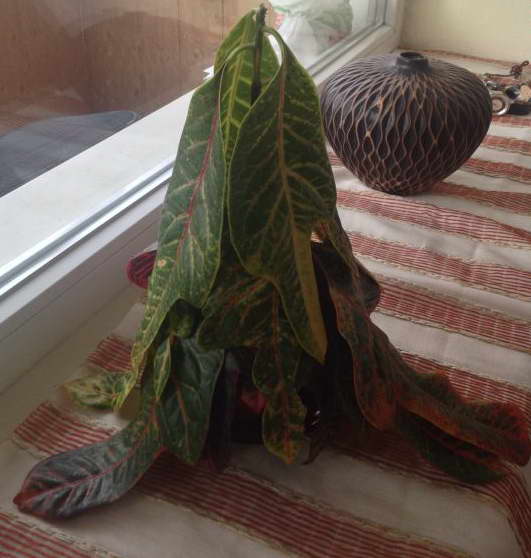

Croton dropped the leaves what to do
- If Croton has dropped the leaves, it means he cannot "drink". This happens from hypothermia of the roots. The plant needs to be rearranged in a warm place, let the earthy coma dry out a few cm deep, stop feeding, reduce watering, spray the leaves well and put a transparent bag on the plant.
- Don't worry if the lower leaves of the croton dry out - exposing the bottom of the stem is a natural process.
- If only the tips of the leaves dry up, then the air humidity is low, you need to maintain the humidity of about 70% by regular spraying and rubbing the leaves with a damp sponge.
- When the edges of the leaves dry and brown spots appear on the leaf, it means that the croton is not warm enough.
- Croton sheds leaves for a number of reasons: from chronic insufficient watering, low humidity, from sudden changes in temperature and drafts. You need to identify exactly your cause and eliminate it.
Croton dry leaves what to do photo
A plant in such a deplorable state requires urgent resuscitation: put a humidifier next to it, spray the leaves more often, make sure that there are no bumps in the room and that it is warm enough (20-22 ° C). Water for irrigation should only be warm, and the soil should be moisture-permeable. If the earthen lump has hardened too much, transplantation into new loose soil will be required; garden soil with a high clay content will not work. It is better to purchase a special soil for ficuses.
Overflow is also fraught with dropping leaves. If you notice signs of stagnant water, you need to reduce the frequency of watering.
In order to prevent putrefactive diseases, treat the plant with phytosporin.
Signs and superstitions about Croton in the video:
Pests
Sometimes the codiaum is attacked by various pests: scale insects, spider mites, etc. They literally draw sap from the plant. What to do in this case? Fight insects. First, using improvised, folk methods. If they do not help, then resort to insecticides.
Croton foliage is an indicator of its condition. On it, the attentive owner always finds out in what condition the plant is, what suits him, what is missing, etc. Therefore, always carefully consider this whimsical handsome man.
Croton or codiaum is a magnificent houseplant of the Euphorbia family, with very beautiful, bright leaves. In nature, it is found only in Southeast Asia, where it can reach about 4 meters in height. At home, croton grows no higher than 60-70 cm. Its characteristic feature is thick, fleshy leaves of various shapes and colors. The color can vary from greenish-yellow to orange-red, and even black, and the shape can be straight, lanceolate, with wavy or even edges, spatulate, twisted, etc.
Croton - home flower with unusual foliage
Croton proper care video
As it was written above, the key to the absence of yellowing and leaf fall in Croton is proper care and timely elimination of possible causes of the disease, so we recommend watching this video.
A week later, the procedure was repeated. Now I watch how the house plant slowly comes to its senses and builds up its green mass. In this article, I will tell you why croton leaves can dry out, what to do in this case.
The people call this beautiful indoor croton flower codiaum. It has incredibly beautiful fleshy leaves of various shapes. A characteristic feature of these leaves is their multi-colored color from light green to black, depending on the variety.
If you take care of it properly, replant it on time, feed it, then it can easily grow up to one meter in height.
This flower is one of the most demanding plants to care for. Its juice is quite poisonous, so it is undesirable to let animals and small children come to it. And transplanting and pruning should be done only with protective rubber gloves.
Usually croton grows without problems, if its lower leaves fall off, then there is no need to worry - this is a natural process of any plant. The alarm should only be raised if:
- Leaves fall in large numbers.
- The tips of both young and old leaves dry out.
- The greenery began to be covered with spots of different colors.
The main reasons for this phenomenon may be:
- A sharp change in air temperature.
- Untimely watering.
- Infection with pests and diseases.
- Decrease of air humidity in the room.
- Getting used to a new pot and soil after transplanting.
- Frequent movement of the flower pot around the room.
- Lack of lighting.
If the codiaum has just been purchased from a gardening store, then there is no need to worry, since all purchased flowers first lose their green mass. Here you just need to water it in a timely manner and monitor its condition for two weeks.Usually, after such a time, the flower fully adapts.
The reasons why croton leaves dry and fall
Croton is considered one of the most capricious and demanding plant conditions. The juice released when the stems of the plant are damaged is extremely poisonous, therefore, when caring for Croton, you must be very careful, wear rubber gloves. Not recommended for families with small children and pets
.
Growing it at home is not easy at all, but possible. The main thing is to monitor the appearance of the leaves. If they begin to turn yellow and fall off, then there may be many reasons for this.
The main ones are:
- violation of temperature and light conditions;
- improper watering;
- damage by diseases and pests;
- insufficient humidity in the room;
- adaptation after transplant.
These symptoms often appear immediately upon purchase of the plant. Croton is very difficult to get used to the new conditions of detention, but if all the necessary criteria are met, then after a couple of weeks the leaves will stop turning yellow and fall off. What to do when the plant starts to hurt, and how to properly care for it?
Watering
The cause of foliage loss can be a violation of the irrigation regime.
Insufficient or excessive watering can cause yellowing and loss of foliage in croton. It is important to ensure that the soil in the pot is always moderately moist.
Water the plant with warm (settled), soft water. Once every 2 weeks, Croton is given a plentiful shower, and the leaves are also regularly sprayed. So that during such a procedure, the earth is not washed out, it is recommended to cover the pot with a film. In the summer, the flower will have to be watered every 2-3 days, and in the winter - once every 5 days.
Temperature regime
An equally important parameter for the normal growth and development of croton is the correct air temperature. It should not drop below +16, although this temperature is already dangerous.
Rotting of the root system and the death of the plant may begin.
The ideal temperature in summer is within + 23 + 25, not lower or higher, and in winter - up to +20. Croton does not tolerate sudden changes and fluctuations in temperature. Any drafts are very dangerous for him.
Air humidity
Insufficient moisture causes yellowing and foliage falling
Croton grows well only in a room with high humidity, therefore it is recommended to put it on a special pallet with moistened moss or expanded clay. A small amount of water is regularly poured into the container, which, evaporating, creates the necessary conditions for the growth of the plant.
Some experts advise not only to spray, but also to gently wipe the croton leaves with a damp sponge or napkin. This will remove dust and dirt from them and humidify the air around. Throughout the entire heating period, you can use electronic humidifiers. A dry indoor climate contributes to the development of many diseases and the appearance of spider mites.
Lack of micronutrients
Croton leaves often dry and fall off due to lack of nutrients in the soil. Timely feeding or transplanting into fresh soil can help.
In order to prevent yellowing of the leaves, it is necessary to regularly make complex mineral dressings. In the period from April to November, the plant is fertilized twice a month, and in the winter - once a month. Before applying fertilizers, the soil is well moistened, and minerals must be dissolved in water, according to the instructions.
Invalid placement
Croton should not be placed in close proximity to heating devices
Croton grows poorly near window glass or near heating appliances. Temperature changes are detrimental to the plant. The best place for it is wide window sills on the west or east side of the apartment.
It is important to ensure that there are no even short-term drafts, and to protect the exotic pet from direct sunlight. If there are no other reasons for illness and foliage falling, then you will have to change the location of the plant.
Failure to comply with lighting conditions
Best of all, Croton feels in diffused lighting. Direct sunlight is destructive for him. If the plant did not last long under the scorching sun and was burned, then it is still possible to help it. It is enough just to rearrange it in partial shade.
Why do croton leaves dry when conditions change?
Sometimes flower growers forget that changes in weather and season outside the window also affect indoor plants.
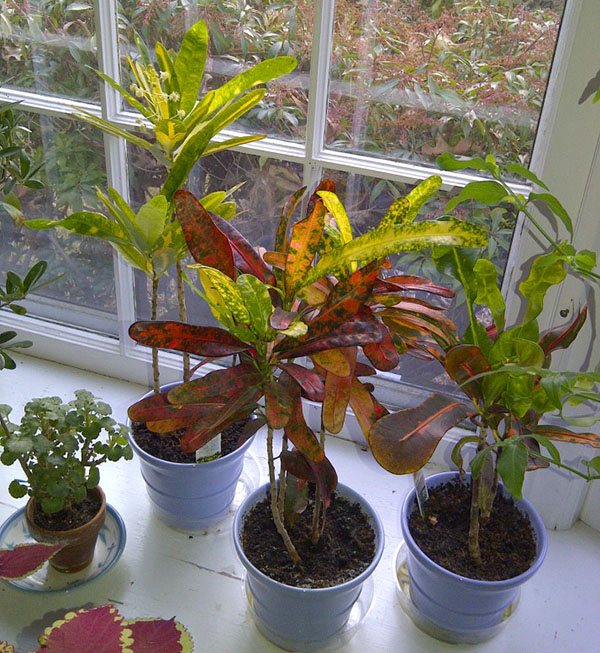

Asking the question: "What to do if Croton leaves fall off?", The florist should pay attention to the temperature conditions of the plant:
- When the room is colder than +14 ° C, growth and other life processes are inhibited to such an extent that the tips of the croton leaves dry out, and then the plant completely discards the foliage.
- At temperatures above +24 ° C and low air humidity, you can see how the croton leaves have sank.
Croton lowers leaves in direct sunlight. When this impact is short-term, nothing bad will happen. It is worth returning to the partial shade, beloved by the plant, and the leaves will return to their original elasticity and beauty. But prolonged sunbathing under the scorching rays leads to the oppression of the flower. As a result, leaves fall off the croton.
If you do not return the flower to comfortable conditions, the situation will worsen until the death of the home plant.
It is possible that croton is losing foliage, lacking nutrition. Descending leaves, even under normal conditions and with sufficient watering, indicate the need for a transplant or a large indoor culture.
Video about the problems of croton care
Croton (codiaeum) is a plant of the Euphorbiaceae family, which grows naturally in the jungles of Southeast Asia, as well as on the islands of the Pacific Ocean. This is an evergreen shrub that, in ideal greenhouse conditions, reaches a height of 3-4 meters, but in a room culture it grows up to 50-80 cm. The stem of the plant is erect, branching. Crotons have bright leathery leaves of various colors, from yellow and green to orange and red, almost black. The forms of leaf blades are also diverse: linear, oval, lanceolate, guitar-shaped, lobed, with wavy edges, twisted, stretched, even. Croton leaves can grow up to 30 cm. In rooms it blooms rarely with inconspicuous small flowers, collected in a loose brush. It is recommended to remove them so as not to weaken the plant.
Croton is a whimsical and difficult plant to care for. Milky sap, which appears when the stem or leaves are damaged, is poisonous, therefore, in a house where there are small children and animals, it must be grown with care, it is also necessary to protect the skin of the hands when manipulating the plant (transplanting, pruning). Crotons need very good lighting, with a lack of light, their leaves lose their decorative effect. The plant does not tolerate drafts and temperature changes, it is warm and moisture-loving. In summer, he needs content at +25 ºС, in winter - at 15-18 ºС. Croton propagates by cuttings, and phytohormones and heating are used for their rooting, as well as air layering. Young plants are transplanted once every one to two years, adults - as needed. Crotons are fed only in summer.
- Lack of moisture for a tropical moisture-loving plant leads to drying of the leaves and their loss.
- Direct sunlight on the leaves causes burns, especially if the plant is sprayed with water.
- Croton's main enemy is the red spider mite. Symptoms of the defeat of this pest are the appearance of a cobweb with red dots on the juicy young parts of the plant and the subsequent drying and falling of the leaves.
- The defeat of the scabbard also leads to the loss of leaves, even old ones.Brown or yellow waxy shields appear on the plant - these are pests that quickly form colonies.
- Mealybugs are less common on crotons than spider mites and scale insects, but they can also settle on the plant and damage it.
If Croton leaves turn yellow, dry and die off, you need to carefully examine the plant and determine if there are any pests on it. If a red spider mite is found, you should first clean the plant with a cotton swab dipped in alcohol, and then treat it with acaricides, actellic or systemic insecticides. You can apply a two-day infusion of garlic minced through a meat grinder (100 g per 3 liters of water), it is recommended to add 10 g of soap to it.
The scale insects and worms are first removed by hand with a cotton swab dipped in alcohol or soap solution, and then the plant is treated with an insecticide.
If there are no pests on the plant, the reason for the poor condition of the leaves may lie in the conditions of its maintenance. Croton should not stand in direct sun, in drafts or near a heater, as well as near window glass (due to temperature differences). The most comfortable place for him is an east or west wide window sill.
You also need to check the watering regime - the plant may not have enough moisture. The soil in the croton pot should always remain moist, but stagnation of water is undesirable. Watering it preferably with warm water, it is necessary to sprinkle the leaves, shower, as well as maintain air humidity around the plant (you can put the croton pot on wet pebbles or expanded clay). In summer, watering is plentiful, once every 2-3 days, in winter - once every 4-5 days.
Frequently asked questions: Croton
1. I was presented with a croton, I don’t know what to do with it, what habits it has.
Answer:
It is advisable to transplant Croton into special ground. It's called Codiaum. Or ask the land most suitable for him at a flower shop. Good watering so that the soil does not dry out too much. Bright enough light for the variegation of the leaves (but not direct sunlight), spray every day, you can wash it once a week under a lukewarm shower. Croton loves warm and humid air, so it is advisable to buy another pallet, put drainage in it and pour water, it is important that the roots do not have water. The pot should be large enough, but not too large. Croton's roots are quite powerful, and when transplanting, it is still advisable to look at the state of the root system and the earthen coma, because it is customary to increase the capacity slightly, so that there is no more than 3-4 cm between the old lump and the walls of the pot. Well, you should not bury it, make good drainage. Croton carisulka! As what is wrong, leaves down and mortal resentment against the owner. ". Give me a drink, I am cold, I am hot, it blows and shines for me, and in general you do not love me. "This is not a complete list of his grievances. Give him a real resort. Everything should be normal, and humidity and watering, indirect sun, washing of leaves, and of course love and markets with him during the procedures.
2. Croton motley throws out new leaves, but does not want to change their color.
Answer:
If he began to throw out green leaves with the onset of autumn, then he clearly does not have enough light.
3. My croton sheds leaves. Almost the entire stem is already bare - except for the top.
Answer:
Check the plant for spider mites. Very often crotons shed their leaves precisely because of this pest (provided, of course, the temperature and watering regime is observed). In addition, if this is the first wintering for your croton, then it is not surprising that he sheds leaves. I did not have time to adapt, it is bad for him, there is not enough light and humidity. He should be closer to the sink under the lamp. If it is on the windowsill, then the problem is in the temperature, Croton does not tolerate overcooling of the roots and the slightest drafts. Cutting the top is not worth it, because croton is not easy to root at all, in the middle of winter it is almost impossible.
four.My Croton's lower leaves were crumbling, he looked like a "palm tree".
Answer:
Place it under the lamp on a pallet of damp expanded clay. You can't do anything with a bare stick, but the remaining leaves can still be saved. While the plant is adapting, it may shed a few more leaves. In the summer, the croton will grow up and the bare trunk will not be so conspicuous. If it does not branch, you can pinch the crown in late February - early March.
Read also: Strawberry Crown and its cultivation
5. How best to root the top of the croton - in water or in the ground. And what conditions to create (do you need bottom heating and lighting?). And do I need to keep in Epin?
Answer:
Method 1: rinse the cut, dip it in the root, put it in the water on the battery, carefully wrapping it in a plastic bag. Ventilate once every 2 days, then spray the leaves with water and back into the bag on the battery. Method 2: just keep in water until the roots have given up. It is only necessary that the stalk be freshened.
6. I transplanted croton, and after a while he hung up all the leaves. What to do.
Answer:
Place it under the bag - the leaves will "stand up" again. Only you don't need to fill in, it's just a reaction to the transplant - perhaps the roots were washed or part of them was damaged. After a week, remove the bag and spray it often for the first time. Although such capricious as croton, it is better to transfer it without breaking the earthen coma and sprinkle it with epin 2 times. And then he can throw off the leaves. And as it comes to life, accustom to life without a package gradually.
7. Rooting of the Croton leaf.
Answer:
This is, in principle, possible - if you need a croton leaf with roots. He will never become a tree, it is necessary to root a leaf with a handle and a bud.
8. There are kidneys on the stem, but they have not woken up for about a year. What should be done to wake up the kidneys?
Answer:
Any removal of the growth point stimulates branching - that is, if you remove the growth point at the top, the buds should wake up. And it is better to hold it under the film, it is more likely that you will still wake up. If still not, the second option is to root the top.
Withering
Why did croton's leaves drop? What to do?
In most cases, the cause of the wilting of croton leaves lies in lack of lighting.
Also the leaves are dropping when overdrying the soil.
To cure a plant, start it
water, but gradually.
In no case do not immediately fill the soil with water
since after that
the root system will begin to rot
.
For a start, it would be nice to water the plant with warm water, where you need to add Elina fertilizer.
After the soil is dry little by little
increase the amount of watering. You can also sprinkle a little water on the croton leaves.
Caring for croton at home is a painstaking and laborious process, and if all the requirements are not met, the leaves begin to fall off the plant. A beautiful plant with large leaves of interesting colors will give any room a completely different look.
If you find an error, please select a piece of text and press Ctrl + Enter
.
Plant croton (Latin Croton)
, it is
codiaeum (lat.Codiaeum)
or
"Cloak of Joseph"
, belongs to the genus of the Euphorbia family. Nobody knows for sure what the name "Croton" means, which gardeners liked more than the scientific "codiaum", translated from Greek as "head". Maybe this name comes from the name of a city in southern Italy, in which Pythagoras once founded his school, or maybe in some dialect this word means "bush" ... The homeland of wild crotons is the islands of the Pacific Ocean and Northern Australia, India, as well as Southeast Asia.
The number of species in the genus varies from 17 to 1200, but in indoor culture croton flowers are represented only by variegated croton and its hybrids. The croton flower is one of the most beautiful decorative deciduous indoor plants, which serves as a wonderful interior decoration and, as a rule, does not take up too much space. In some countries, the houseplant croton is considered a hearth keeper, protecting the house from poor energy.
Plant care
Most often, the loss of leaves by croton is observed with improper care. The most common cause of foliage loss is improper lighting.With insufficient lighting, there is not only a loss of color intensity, but also a loss of foliage. At lunchtime, it is necessary to ensure that direct sunlight does not fall on the flower.
It is best to place the flower on an east or west window. Excessive drying or waterlogging of the soil is strictly prohibited. In the summer, the plant needs a sufficient amount of water. In winter, it is recommended to reduce the frequency of watering.
Watering is carried out as the soil dries up. With excessive watering, the development of various diseases and leaf fall in croton is observed.
With excessive dryness of the earthen coma, the loss of almost all foliage on the crop can be observed. The plant does not tolerate cold water. That is why it is necessary to use water at room temperature for irrigation.
In the presence of drafts, the plant can shed its foliage. That is why it must be limited from the influence of this unfavorable factor. There are many different factors, under the influence of which, shedding of leaves from croton is observed.
Croton transplant
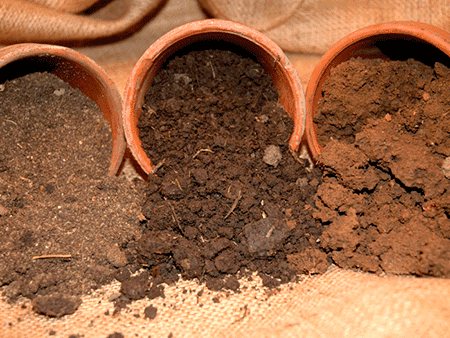

To transplant croton, you should use shallow and wide containers. The drainage layer (at the bottom of the pot) should be at least 3 centimeters long, for this you can use expanded clay, broken brick or ordinary fine gravel. The pot itself must be placed in a tray of gravel, in which there will always be water. This will allow you to permanently maintain the moisture content of the earthy coma.
Planting or transplanting a plant is usually done in summer or spring. Croton should be placed in a small hole in the soil so that its root system does not touch the drainage layer.
Young crotons need
annual transplant, it should be carried out in the summer or spring. Mature plants require replanting as the pot fills with the root system. At the same time, the volume of the new container should not greatly exceed the volume of the old one, and the diameter should be 3-5 centimeters larger, and before transplanting, it is necessary to add high-quality fertile soil to the pot. You should not transplant croton if you do not know exactly how to do it in a timely manner and correctly, this can only harm your plant or even ruin it.
By pinching off the top shoot of the plant, you can give it the shape of a bush, although its natural crown shape is the shape of a small tree. However, you should not rely on rapid crown formation, since the side shoots grow much slower than the stem.
Croton leaves fall from dry air
Among the reasons why Croton leaves dry, there is often such a florist's mistake as excessive dryness of the air in the room, for example, in the winter months, when the heating is on.
And at this time, and in summer, the plant needs to be pampered with a warm shower, for which they take settled soft water. A useful hygienic procedure for an exotic guest will be wiping the sheet plates with a damp cloth. And to humidify the air, it is convenient to use specialized household appliances or put the pot in a tray with wet moss or expanded clay.
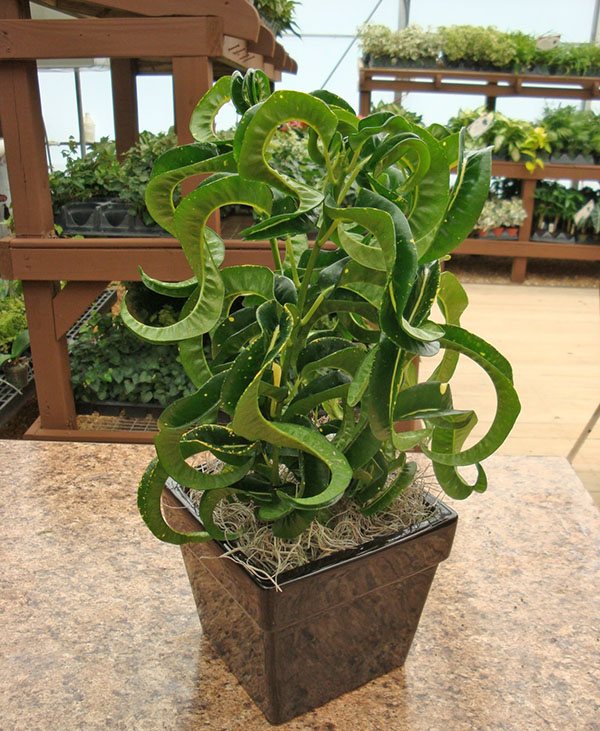

If in the room where the plant is located, high humidity is constantly maintained, the florist is unlikely to notice that the tips of the leaves of the croton are drying, or the foliage falls prematurely early. In this case, greens live much longer than in normal indoor conditions.
Staying in dry air weakens the plant and provokes attacks on croton by such a dangerous pest of indoor crops as spider mites. This is another reason why croton leaves dry and fall off.
Major diseases
Croton leaves can fall off with a variety of diseases. If the tips of the leaves of the plant dry up, then this indicates insufficient watering.Also, this can be observed when ultraviolet radiation hits the flower. With improper care, a variety of parasites can develop on the plant.
Video about proper croton care:
The appearance of a spider mite is most often observed on a culture. With poor and irregular soil moisture, mealybugs or scale insects can be observed. To eliminate parasites, the use of systemic insecticides is recommended.
Their use is carried out according to the instructions. Otherwise, their negative effect on the plant may be observed. If, after the first treatment of the plant, the foliage continues to fall off, then a second course is carried out. Almost all plant diseases occur with irregular watering and insufficient air humidity.
By ensuring optimal air humidity and proper watering, a variety of diseases can be eliminated. To ensure an optimal level of air humidity, it is recommended to use special humidification. Croton is a poisonous plant. That is why the appearance of parasites and pests is rarely observed on it.
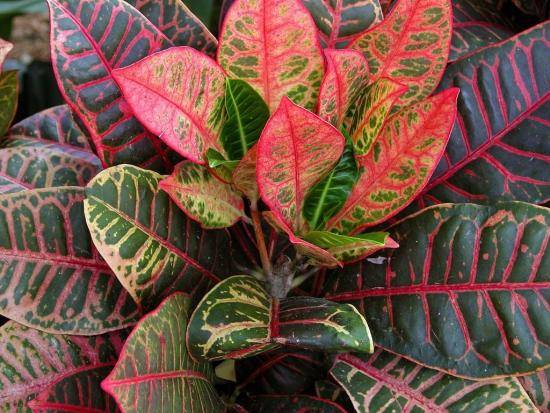

But, when creating insufficiently comfortable conditions or improper care of the flower, their development can be observed. Croton is a unique flower, the aesthetic value of which lies in its original foliage. With improper care of the plant or the development of various diseases, the dropping of leaves by croton can be observed. Elimination of this trouble should depend on the reasons for its occurrence.
KROTON dropped the leaves, how to save. Description of the plant
Croton (codiaum) is an evergreen perennial plant of the Euphorbia family. There are 14 known species. In indoor floriculture, numerous varieties and forms of codiaeum (croton) variegated (Codiaeum variegatum var.pictum) are widespread.
Shiny leathery leaves have different shapes (more than two dozen variants), bizarre outlines and colors. On the leaves you can see pink and bronze spots, lemon, yellow and orange stripes, red, pink and yellow streaks, black eyeliners, etc. Some growers call this leaf color painting.


Very beautiful shape and color of the leaves of this codiaum (croton)
Croton, an ornamental deciduous shrub or a low, branched tree with brightly colored leaves, is popular in many countries. In warm regions, it is grown in the open air, but for us the motley croton (codiaum) remains only a houseplant. Large specimens are kept in greenhouses, conservatories and offices. Designers use branches and brightly colored leaves when creating bouquets and various compositions.
The breeders managed to develop fantastically beautiful compact varieties that are suitable for small spaces. Unfortunately, all crotons are demanding in care and do not forgive those oversights that other indoor plants do not notice.
Croton flower - features of cultivation
The indoor flower croton is a bush with leathery leaves of various forms: asymmetric, oblong-lanceolate, pointed or obtuse, whole-edged, three-lobed, notched, broadly ovate, etc. Young leaves, usually of lighter yellow-green hues, acquire richer green and burgundy colors over time, so your home croton flower is colored like an elegant autumn forest. A common feature for leaves of all varieties and varieties
- pronounced venation. The bloom of croton will not cause you delight, since it is a hanging axillary carpal inflorescence of nondescript cream flowers.
In the photo: Croton growing on the street
The home croton flower has earned the fame of one of the most capricious plants. What are the features of croton care?
- Croton juice is poisonous. It causes diarrhea, vomiting, contact dermatitis, so all work with Croton must be carried out with gloves.
- Croton at home needs not only spraying the leaves from a spray bottle, but also wiping them with a damp sponge. Give Croton a warm shower every month in the summer.
- Croton does not tolerate watering with cold water and drafts!
- Sometimes at the beginning of the growing season, croton leaves take on strange shapes. How this is explained, no one knows, but croton has a high degree of mutability, and therefore it became possible to breed many varieties and hybrid forms of this plant, and they differ only in how the leaf of a particular croton variety looks.
- The nondescript bloom of croton takes a lot of energy from the plant, and if you are not going to engage in breeding experiments, it is better to remove flower buds or flower stalks immediately.
Special energetics of Croton
Croton came to us from the Pacific Islands and from distant Australia. The plant has a second name - codiaum, which means "head" in Greek. If there is no external similarity, then you can look for the internal connection of the plant, which has its undoubted effect on humans. It is generally accepted that croton helps to gain faith in oneself and in creative possibilities, stimulates the development of eloquence, and most importantly - balances emotions and puts thoughts in order, strengthens immunity, increasing the body's resistance.
The presence of croton in the house purifies the energy of the room, but its beneficial abilities are significantly enhanced under the condition of energetic interchange, if a person not only pays attention to the plant living with him under the same roof, but loves and admires it. Croton amazes with its magnificence, beauty and grace.
May there be more beauty in the world
To share this beauty with friends and acquaintances, Croton can be propagated using cuttings from partially woody shoots, which are carefully cut, washed from the milky juice and rooted in water. In early spring, you can cut off the leaf, capturing the axillary bud and a thin strip of bark. After a couple of weeks, the kidney will wake up and give a sprout, but for this you need to heat the tray with water in which the green stalk is placed.
Attention! It is necessary to strictly restrict access to croton to small children and pets, and to carry out all manipulations with the plant with gloves.
Thoroughly wash your hands in case of contact with milky juice, which is very poisonous and can be dangerous to health and life. This is how the most beautiful and terrible things are combined in our world and the most beautiful and terrible, but there should be more goodness and beauty.
Prevention measures
The main preventive measure to avoid the problem of fallen leaves in croton is to follow the rules of caring for it, the main points of which are.
The process of foliage loss is most often a signal of improper care or illness, but there are exceptions, that is, a natural process. In this article, we will try to figure out why Croton's leaves dry and fall, as well as what to do in this case and whether new ones will grow.
Causes of leaf fall in Croton
Croton has an unusual color of leaves - reddish-yellow, so it is quite difficult to immediately identify signs that they are drying out. Usually, the problem is noticed after the leaves have already begun to crumble. This happens mainly due to improper watering and due to pest infestation.
Croton sheds leaves as a result of both excess moisture and its lack. Air humidity is also very important for this plant, in too dry air, it feels very bad.
The most common pests that infect croton are spider mites (signs: the appearance of a cobweb on the lower leaves and loss of color) and a scale insect (sign: the appearance of waxy black-brown spots on the leaf plate).
The shedding of leaves in croton can also be associated with a draft formed in the room where it stands, or a sharp change in temperature.
What to do when Croton leaves fall?
If a flower throws off old leaves located in the lower tier in a small amount, then this is a natural process. In cases where even the foliage that has just appeared falls, then you should pay attention to caring for the flower.
If a characteristic sign of croton damage by pests is found, it should be treated: from the spider mite - "Aktellik", from the scabbard - "Karbofos" and cut off.
Croton treatment
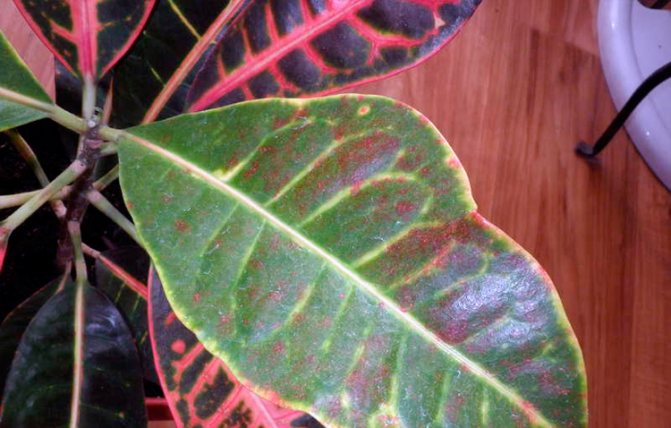

Treatment for red spider mites and other pests
If the leaves of croton turn yellow, dry and die off, it is necessary to carefully examine the plant and determine if there are any pests on it. If a red spider mite is found, you should first clean the plant with a cotton swab dipped in alcohol, and then treat it with acaricides, actellic or systemic insecticides. You can apply a two-day infusion of garlic minced through a meat grinder (100 g per 3 liters of water), it is recommended to add 10 g of soap to it.
The scale insects and worms are first removed by hand with a cotton swab dipped in alcohol or soap solution, and then the plant is treated with an insecticide.
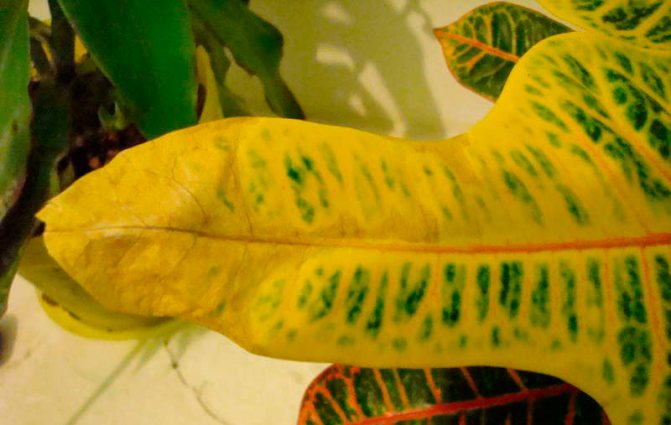

Violation of conditions for keeping croton
If there are no pests on the plant, the reason for the poor condition of the leaves may lie in the conditions of its maintenance. Croton should not stand in direct sun, in drafts or near a heater, as well as near window glass (due to temperature changes). The most comfortable place for him is an east or west wide window sill.
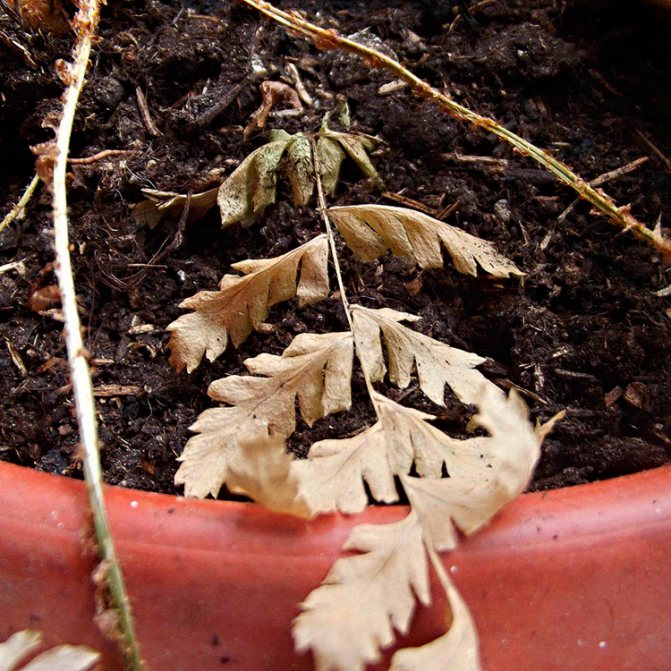

Improper watering of croton
You also need to check the watering regime - the plant may not have enough moisture. The soil in a croton pot should always remain moist, but stagnation of water is undesirable. Watering it preferably with warm water, it is necessary to sprinkle the leaves, shower, as well as maintain air humidity around the plant (you can put the croton pot on wet pebbles or expanded clay). In summer, watering is plentiful, once every 2-3 days, in winter - once every 4-5 days.
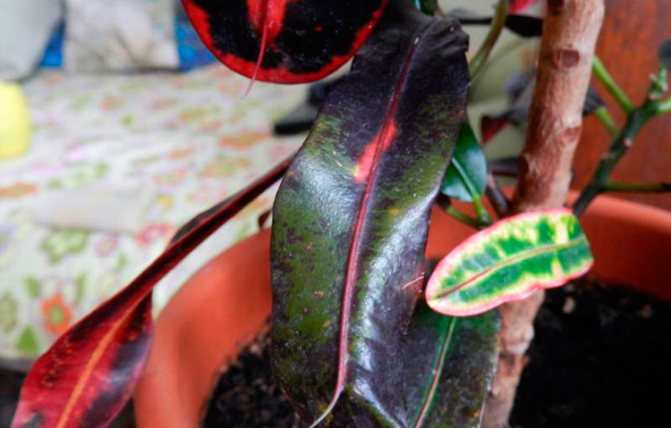

Effective rescue measures
Temperature extremes are unacceptable for croton, and it is completely necessary to refuse to keep it on the windowsill in winter. In summer, croton leaves fall off due to insufficient soil nutrition, because in the period from March to August, the plant must be fertilized regularly. Well, the infection of the plant with a tick must be treated, for example, we spray it with Actellik, as well as maintaining high humidity in the room.
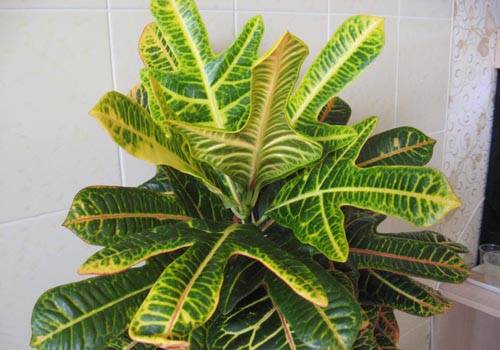

Croton will be grateful for the opportunity to breathe fresh air in the yard or on the veranda, to drink sunlight, without which its colorful foliage turns pale and loses color. It is necessary to periodically gently wipe the leaves with a damp cloth, removing dust from them, so that natural gas exchange is not disturbed.
The tips of the leaves dry up
Why do the tips of the leaves dry on Croton?
Most often the reason for this is too low air temperature
.
What temperature conditions are suitable for codiaum? Normal temperature
for growing this plant
+ 14 ... + 20 degrees.
In order for Croton to grow and develop well, it is necessary to provide him balance of moisture and heat
, because insufficient watering can also be the reason why croton leaves dry.
Control measures
In order to avoid the death of a plant when dropping leaves from it, certain measures must be taken. When the first fallen leaves appear, it is necessary to spray croton. It is also recommended to wipe the foliage.
Young plants need to be transplanted annually. This procedure is carried out in early spring. Transplanting old plants can be carried out every year or every other year. The plant should be transplanted into a fertile soil mixture. It should include:
- Sod land
- River sand
- Leaf land
- Charcoal
When the plant is damaged by scabbards, the foliage begins to fade and fall off.With excessively dry air, a red spider mite often develops on the plant. This pest infects the leaf plates, which leads to the appearance of whitish spots and premature fall of foliage.
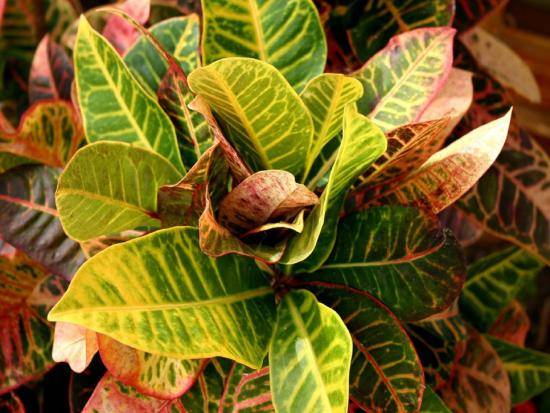

In order to ensure good growth of croton, a well-lit place is needed, which will eliminate the possibility of blanching of the foliage. In case of insufficient plant nutrition, leaf fall can be observed. That is why, after buying a flower, it is imperative to transplant it.
For this purpose, nutrient soil is used. The pot must be selected correctly. Its diameter should be several centimeters larger than the previous one. During the period of plant transplant, it is necessary to take care of high-quality drainage. Proper care is the key to ensuring the beauty of culture. That is why the florist must follow all the care rules.
Prevention measures
The correct conditions of detention are the best prevention against possible diseases. Here are some simple tips to avoid leaf loss:
- it is necessary to provide the plant with a sufficient amount of water and at the same time not to overflow it;
- you need to moisten not only the soil, but also spray the sheets;
- place the pot away from drafts;
- lighting should be sufficient, but not strong;
- it is important to avoid direct sunlight on the crown;
- Croton should grow in light, drained soil that allows water to pass through well;
- the soil must be versatile and contain turf, compost, sand, peat;
- the pot should be commensurate with the root system of the plant - if there is not enough space for the roots, the leaf deteriorates;
- you need to "feed" the plant according to the care recommendations.
Croton is easy to care for - even a novice florist can handle this. This plant will decorate any interior thanks to the beautiful color and shape of the leaves, so the loss of each leaf affects its appearance and makes the owner very upset. To prevent this from happening, it is enough to follow basic care recommendations.
Decorative croton leaves, striking both connoisseurs and beginners in floriculture with a variety of shapes and colors, this is the main distinguishing feature of a houseplant. When croton's leaves dry and fall, and the exotic handsome man who recently decorated the room loses much of its attractiveness, its owner has many reasons to worry.
On the one hand, the fall of leaves from the lower tiers of the stem is a natural process, which is necessarily accompanied by the appearance of new foliage at the top. The Croton owner needs to sound the alarm if:
- shoots are rapidly becoming naked;
- even young foliage dries and dies;
- the tips of the leaves dry on croton;
- yellowing and wilting appears as spots in the center of the leaf plate or along its edges;
- the gain does not have time to compensate for the losses.
Why do croton leaves dry? What are the mistakes made by the florist, and how to fix the situation?
In most cases, the reason should be sought in violation of plant care, changes in conditions of detention, for example, when changing the season or moving croton to another room. Sometimes indoor culture is affected by insects that negatively affect the state of the foliage and depress the whole plant.
Change of color of the plant
Why do croton leaves turn yellow? If the flower has changed color, this may indicate about insufficient lighting
.
Croton demands quite a lot of light
, but still in direct sunlight
better not to bet
, since due to burning of the leaves, the plant also loses its former color and begins to turn unnaturally yellow.
How to determine that the codiaum has an excess of light? On the leaves of the flowerpot will begin to appear brown spots.
If the plant does not turn yellow
, but simply grows dull, which means most likely it lacks trace elements in the soil, especially nitrogen.
Why does croton have green leaves? This may be due to the fact that the plant is young.
In this case, you should provide croton good feeding
.
Multicolor splendor
At home, crotons grow up to three meters in height, and although in our houses their growth is much more modest, few other plants could compare with this colorfulness and variety of foliage. Sometimes small, pale flowers appear on the croton, collected in hanging tassels, which are usually removed so that the plant does not waste their strength in ripening.
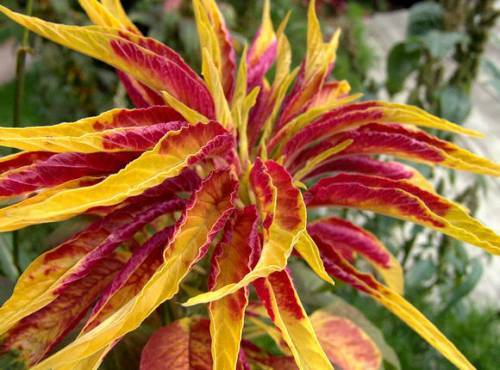

Variegated leaves, which change color as they grow, are of decorative value. Young leaves at the top are colored green and yellowish, while adults are pink, orange and crimson, with multi-colored dashes, spots and bizarre patterns of unthinkable colors and shades. The leaves are also very diverse in shape, with wavy or smooth edges.
Croton is an evergreen shrub, but in adverse conditions it can lose its magnificent foliage, which becomes a serious problem for the grower. It is no secret that we plant most indoor plants in our home or office space because of their beautiful leaves, flowers or climbing branches, because indoor flowers are a real decoration of any room.
Possible reasons
The exotic exotic owner should be wary if:
- Croton is rapidly losing foliage;
- even young leaves turn yellow and dry;
- the tips of the leaves dry;
- leaves turn yellow and wither in the center of the leaf plate;
- the flower sheds more leaves than it forms.
The reason must be sought in the conditions of detention. The crop can be attacked by pests. Perhaps the irrigation regime is disrupted or the plant is under stress (for example, due to transfer to another room). All these points of care must be taken into account so that the exotic always feels good.


Irrigation regime is violated
If your croton has lowered its beautiful leaves, then you are watering it incorrectly. The soil in the flowerpot should always be moist, especially during the summer months. It is impossible to allow the earthen coma to completely dry out even in winter. The point is not to often water the codiaum, as croton growers often call it, but to soak the soil to the very bottom with water. Croton leaves dry if moisture does not reach the rhizome.
The leaf is a kind of "signal flag". Observing the standing of the main decoration of the plant, you can understand whether you are giving enough care to your green pet.
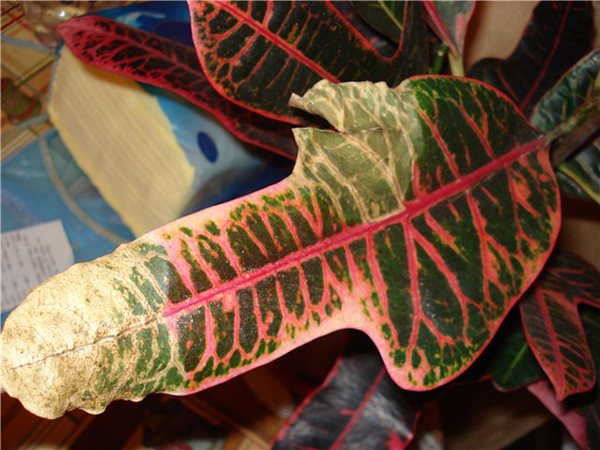

Despite the fact that the earth should not be allowed to dry out, excess moisture is also dangerous for codiaum, especially in winter. If the roots stay in a wet substrate for a long time, they begin to rot. As a result, the trunk receives insufficient nutrition, which immediately affects the state of the foliage.
You can save the plant from waterlogging as follows: 30 minutes after each watering, put the flowerpot in the pan so that excess water flows through the drainage holes, after which the liquid must be drained. Do not forget that in the cold season, watering is reduced.
The root provides the plant with nutrients, so it must be healthy, which largely depends on the watering regime. If, after you have established watering, the situation has not changed, then the plant needs a transplant. Pre-inspect the rhizomes and remove all processes that are severely damaged.
Air is too dry
Dry air is another reason why Croton sheds its leaves. The overseas visitor is accustomed to the humid climate. The plant especially suffers during the heating season, when radiators are working. In order to bring the living conditions as close as possible to natural conditions at this time, you can arrange a warm shower for the codiaum. Just make sure that no water gets on the ground.
The air can be humidified using special devices or simply put the flowerpot in a tray with wet moss.In summer, a warm shower is not required, but it is worth wiping the leaves with a damp cloth.
If high humidity is maintained in the room, then the leaves of the croton will not fall prematurely. But staying in a dry climate will weaken the codiaum and provoke an attack by a spider mite. If these two conditions of care are met, and the foliage of your croton falls off not only from the lower tiers, then the problem lies in other reasons, which we will discuss below.


Drastic changes
It should be remembered that when the weather conditions change outside the window, then the houseplants react to them. When asking why croton leaves fall, houseplant owners should, first of all, pay attention to temperature changes during the maintenance of the flower. If the thermometer in the room shows +14 ° C, then all the processes in the plant's body are inhibited, and the tips of the leaf plates dry, later the plant may even "become bare". And at a temperature of +24 ° C, the leaves can fall. Croton can also lower the leaves by placing the flower pot in direct sunlight.
Moreover, the leaf plates can get sunburn. If it was not for long, then by returning the plant to the shade, you can quickly revive it. But if the plant stays in direct sunlight for a long time, then the leaves begin to fall off.
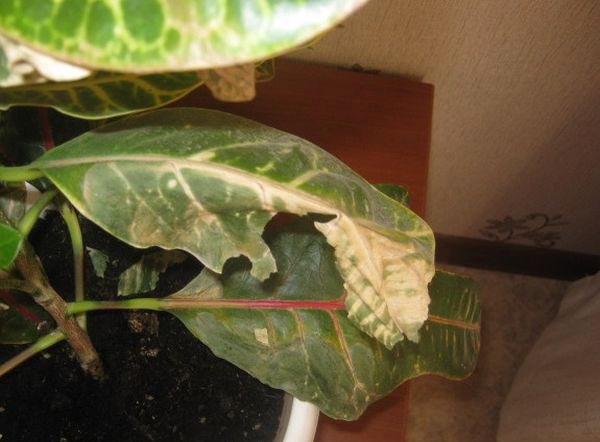

It is possible that the flower lacks nutrition. Dropped leaves are a sign that a crop needs fertilization or needs a transplant. In addition, Croton does not tolerate drafts, which can cause him to throw off the leaves. If the plant has sluggish leaves, then hypothermia of the roots is possible and therefore the flower cannot receive moisture. It should be urgently moved to a warm place, stop fertilizing, reduce watering so that the earthen lump dries well. Spray the leaves all the time, and put on the bag, creating a greenhouse environment.
Well, if the lower leaves die, then you should not worry, since this is a natural process.
Sometimes the leaves begin to turn black. In this case, the flower does not have enough potassium, it needs fertilization.


Diseases and pests
Why else leaves at home codiaum fall, read on.
If you notice that the leaves dry up and die off, then you should carefully examine the plant for pests. The cobwebs on the plant indicate that the flower is affected by the red spider mite. If a spider mite is found, you should clean the plant from the pest with a cotton swab, having previously moistened it with alcohol. At the end of the process of dealing with an uninvited guest (tick), treat the flower with systemic insecticides. You can make a garlic solution from minced garlic and soap and treat the leaves with it. After an hour, the solution is washed off. Most often, spider mites appear when the plant is irregularly watered, not washed or sprayed, since under normal conditions, croton secretes a poisonous juice that protects it from pests. Therefore, if you follow the rules of care, you will avoid visiting harmful insects.
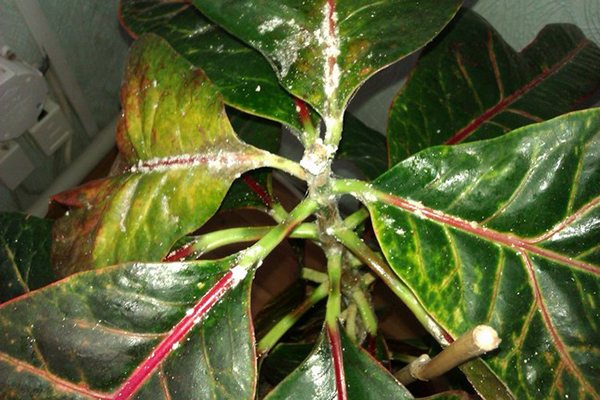

The scabbard rarely infects the plant, but if it does, then it is removed by hand.
If the air is dry, the plant can infect the tick. Its presence can be judged by the white bloom on the lower part of the sheet. Treatment is as follows: normalize care, move the plant to a warm place with good lighting, provide good ventilation and take a warm shower. Treatment with acaricide "Neoron" will help in the treatment of the disease (treat the plant 4 times with an interval of 10 days).
Causes of yellowing of leaves
The homeland of Croton is Oceania and the countries of Southeast Asia, where it grows in tropical forests, which is why it is very important for domestic crotons to maintain comfortable living conditions with warm air and high humidity.This plant requires moderate watering, regular replanting, and a fertilized substrate. The flower is picky about lighting, it does not tolerate any drafts.
Any unfavorable change in the habitat immediately causes a negative reaction of croton - it begins to turn yellow and throw off the leaves. Nevertheless, in the vast majority of cases, a green pet can be saved if timely measures are taken to revive and restore it.
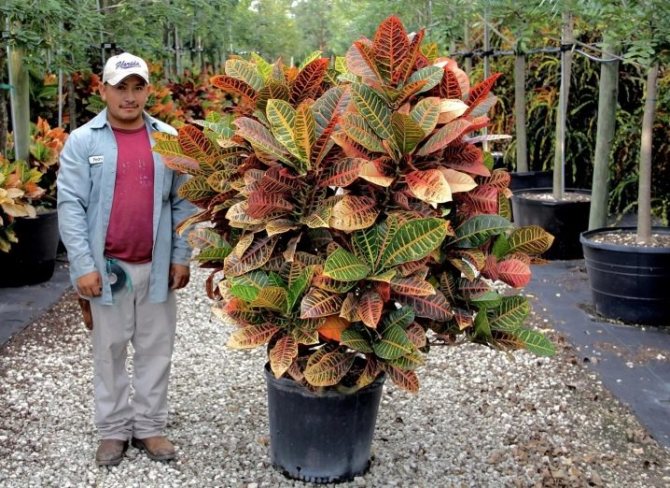

Watering
Most often, croton sheds leaves due to a violation of the irrigation regime. Like most tropical exotic plants, he prefers humidified air and good irrigation, which is why it is important to carefully monitor the condition of the soil - it must be constantly moistened. This is true both in summer, when the weather is hot outside, and in winter, when heating is working in the living quarters.
This green pet reacts instantly to the dryness of the earthen coma: the lower leaves fall, turn yellow and fall off rather quickly, at best only the top will remain of the leaf mass, most often the leaves fall off completely.
To prevent the leaves from falling off, you should water the flower as needed.
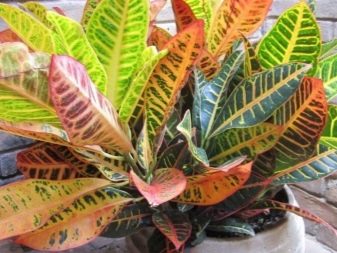

If your plant is large, then you can water it daily, but little by little. However, do not overdo it, moisture stagnation should not be allowed: in this case, the root system will begin to rot, and the aboveground part will not receive the required volume of water and nutrients, which can also cause leaves to fall.
To avoid waterlogging of the soil, when planting croton, you need to pay special attention to drainage - usually expanded clay or gravel is used for this, the layer of which should be at least 1/4 of the total volume of the pot.
It is very important that croton receives moisture not only from the ground, but also from the leaves - the plant “responds” well to spraying its crown from a spray bottle, you can also wipe the leaf plates with a sponge from time to time and arrange a warm shower once a month.
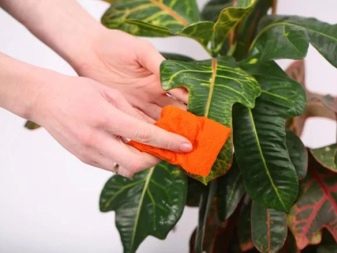

Temperature and humidity
When keeping croton, maintaining a comfortable temperature is of particular importance - do not forget that this is a native of the tropics, so any drop in temperature will be disastrous for him. If the air in the room is colder than +14 degrees, then all necessary life processes begin to slow down to such an extent that the tips of the croton leaves begin to dry out and soon disappear altogether.
If the temperature stays above + 25 degrees, especially in combination with dry air, the foliage drops, and this is a clear indication that the plant has begun to wither due to improper keeping conditions. Too hot air is no less dangerous for croton, but it can always be compensated for by high humidity. - in cold air, the situation can be corrected only by moving the flower to a warmer room.
The optimal environment for keeping croton is considered to be air with a temperature background of + 20-24 degrees. In the warm season, you can take the plant out to the balcony, porch or terrace - this will improve its immunity, however, it is important to prevent direct ultraviolet rays from acting on it.


Location
Very often crotons turn yellow because they are located in the wrong place. Experienced flower growers know that the slightest draft can destroy this plant, so it is best to place a flowerpot with a croton in a corner, in a place where there is no movement of air masses - near the door or near the window.
If the plant is small, then the edge of the window sill is fine.
It is also important not to allow direct sunlight: Croton prefers diffused lighting, so it is best for the flower habitat to choose a window sill in the east and west directions, there will be little light on the north side of the croton, and in the south the sun is too active for him.


